Kenmore Elite 79671433810, 79671433710, 79661433810, 79661433710 Owner’s Manual
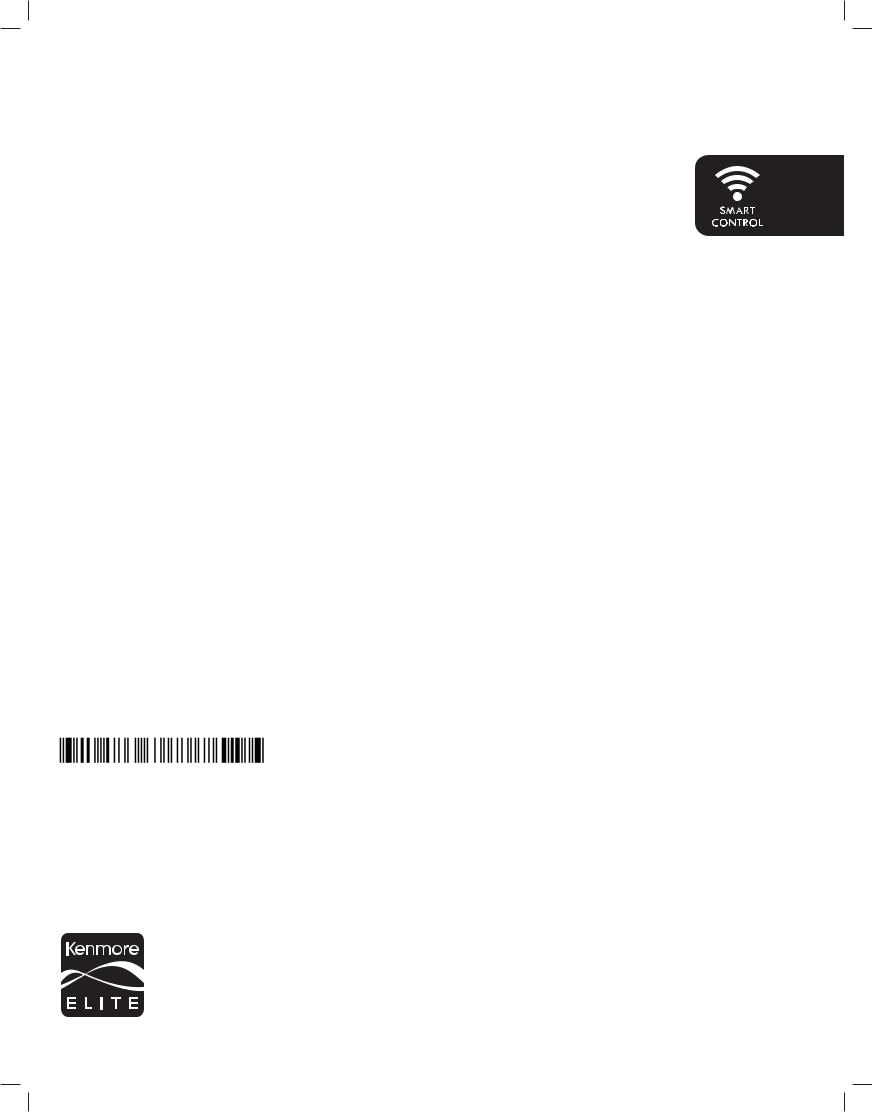
Use & Care Guide
Manual de Uso y Cuidado
Models/Modelos: 796.6143*, 796.7143*
Kenmore Elite®
Dryer
Secadora
* = color number, número de color
MFL69702024
Sears Brands Management Corporation
Ho man Estates, IL 60179 U.S.A.
www.kenmore.com
®
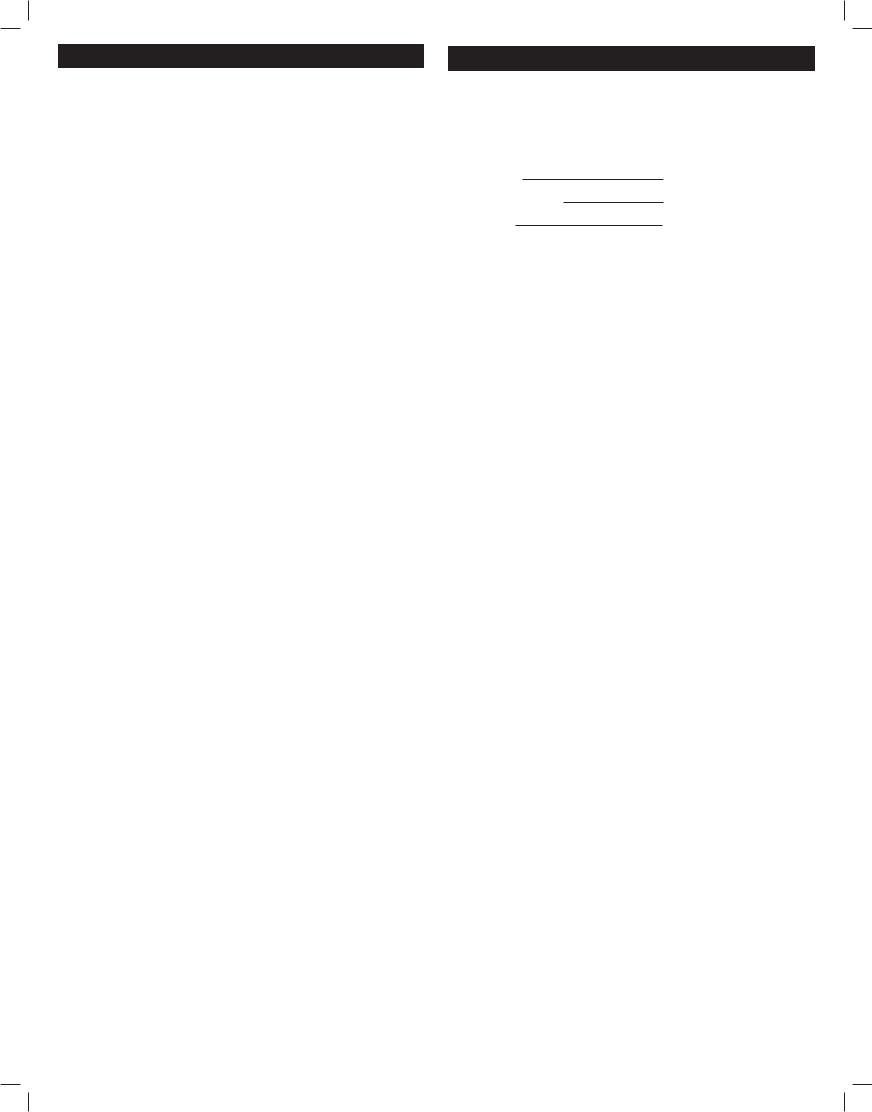
TABLE OF CONTENTS |
|
|
IMPORTANT SAFETY INSTRUCTIONS .................... |
|
3-7 |
GROUNDING REQUIREMENTS ................................... |
|
4 |
FEATURES AND BENEFITS |
|
|
Key Parts and Components ........................................ |
|
7 |
Accessories .................................................................. |
|
7 |
Two-Way Reversible Door.......................................... |
|
7 |
INSTALLATION INSTRUCTIONS |
|
|
Key Dimensions and Specifications .......................... |
|
8 |
Location Requirements ................................................ |
|
8 |
Choose the Proper Location ................................ |
|
8 |
Clearances .................................................................... |
|
8 |
Gas Dryers ............................................................. |
|
10-11 |
Gas Requirements................................................. |
|
10 |
Electrical Requirements......................................... |
|
10 |
Connecting the Gas Supply ................................ |
|
11 |
Electric Dryers ...................................................... |
|
12-13 |
Electrical Requirements....................................... |
|
12 |
Connecting Electric Dryers ................................. |
|
13 |
Venting the Dryer ................................................. |
|
14-15 |
Connecting the Inlet Hose......................................... |
|
16 |
Leveling the Dryer ..................................................... |
|
17 |
Reversing the Door Swing .................................. |
|
17-24 |
Final Installation Check ............................................ |
|
25 |
Installation Test (Duct Check) .................................. |
|
26 |
Restricted or Blocked Airflow.................................. |
|
27 |
HOW TO USE |
|
|
Control Panel Features ............................................ |
|
28 |
Time and Status Display ......................................... |
|
29 |
Operating the Dryer ................................................ |
|
30 |
Using the Two-Way Reversible Door....................... |
|
31 |
Cycle Guide ......................................................... |
|
32-33 |
Sorting Loads ............................................................ |
|
34 |
Loading the Dryer .................................................... |
|
34 |
Cycle Modifier Buttons ............................................. |
|
35 |
Cycle Options and Special Features ...................... |
|
36 |
Smart Features ........................................................... |
|
36 |
Steam Features........................................................... |
|
38 |
USER MAINTENANCE INSTRUCTIONS |
|
|
Regular Cleaning ...................................................... |
|
39 |
Cleaning the Exterior ......................................... |
|
39 |
Cleaning the Interior .......................................... |
|
39 |
Cleaning Around and Under the Dryer |
........... 39 |
|
Cleaning the Lint Filter ....................................... |
|
39 |
Maintaining the Exhaust System............................. |
|
40 |
DIAGNOSTICS................................................................ |
|
41 |
TROUBLESHOOTING GUIDE |
|
|
Before Calling for Service ................................ |
|
42-44 |
WARRANTY ................................................................... |
|
45 |
SERVICE.......................................................... |
Back Cover |
|
PRODUCT RECORD
In the space below, record the date of purchase, model, and serial number of your product. You will find the model and serial number printed on an identification plate located inside the dryer door. Have these items of information available whenever you contact Sears concerning your product.
Model No.
Date of Purchase
Serial No.
Save these instructions and your sales receipt for future reference.
2
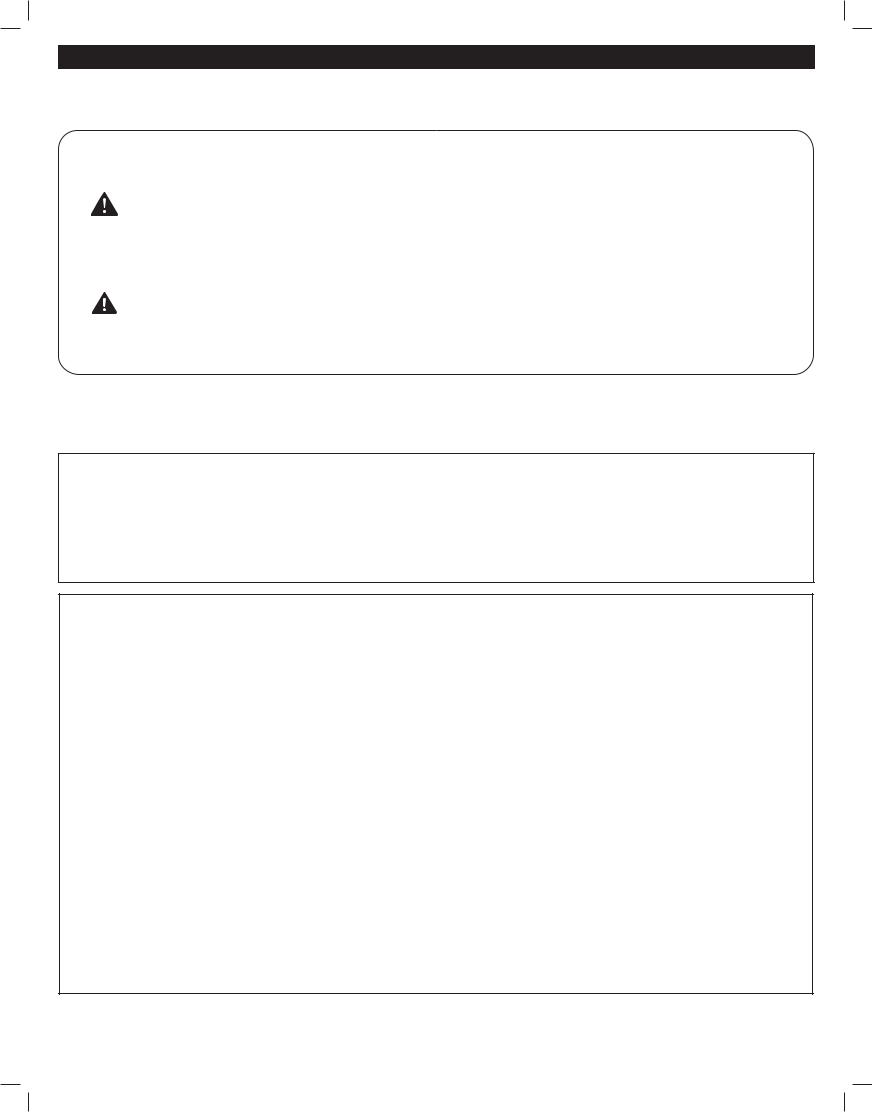
IMPORTANT SAFETY INSTRUCTIONS
READ ALL INSTRUCTIONS BEFORE USE
Your safety and the safety of others is very important.
We have provided many important safety messages in this manual and on your appliance. Always read and obey all safety messages.
This is the safety alert symbol.
This symbol alerts you to potential hazards that can kill or hurt you and others.
All safety messages will follow the safety alert symbol and either the word WARNING or CAUTION. These words mean:
 WARNING: Indicates a hazardous situation which, if not avoided, could result in death or serious injury.
WARNING: Indicates a hazardous situation which, if not avoided, could result in death or serious injury.
CAUTION: Indicates a hazardous situation which, if not avoided, could result in minor or moderate injury.
All safety messages will tell you what the potential hazard is, tell you how to reduce the chance of injury, and tell you what can happen if the instructions are not followed.
 WARNING: For your safety, the information in this manual must be followed to minimize the risk of fire, explosion, or electric shock, or to prevent property damage, personal injury, or loss of life.
WARNING: For your safety, the information in this manual must be followed to minimize the risk of fire, explosion, or electric shock, or to prevent property damage, personal injury, or loss of life.
 WARNING
WARNING
FIRE HAZARD
Failure to follow safety hazards exactly could result in serious injury, death or property damage.
•Do not install a booster fan in the exhaust duct.
•Install all clothes dryers in accordance with the installation instructions of the manufacturer of the dryer.
 WARNING
WARNING
FIRE OR EXPLOSION HAZARD
Failure to follow safety hazards exactly could result in serious injury, death or property damage.
•Do not store or use gasoline or other flammable vapors and liquids in the vicinity of this appliance or any other appliance.
•Installation and service must be performed by a qualified installer, service agency, or the gas supplier.
WHAT TO DO IF YOU SMELL GAS:
1.Do not try to light a match or cigarette, or turn on any gas or electrical appliance.
2.Do not touch any electrical switches. Do not use any phones in your building.
3.Clear the room, building, or area of all occupants.
4.Immediately call your gas supplier from a neighbor’s phone. Carefully follow the gas supplier’s instructions.
5.If you cannot reach your gas supplier, call the fire department.
•Do not install a clothes dryer with flexible plastic venting materials. If a flexible metal (foil type) duct is installed, it must be of a specific type identified by the appliance manufacturer as suitable for use with clothes dryers. Flexible venting materials are known to collapse, be easily crushed, and trap lint. These conditions will obstruct clothes dryer airflow and increase the risk of fire.
SAVE THESE INSTRUCTIONS
3
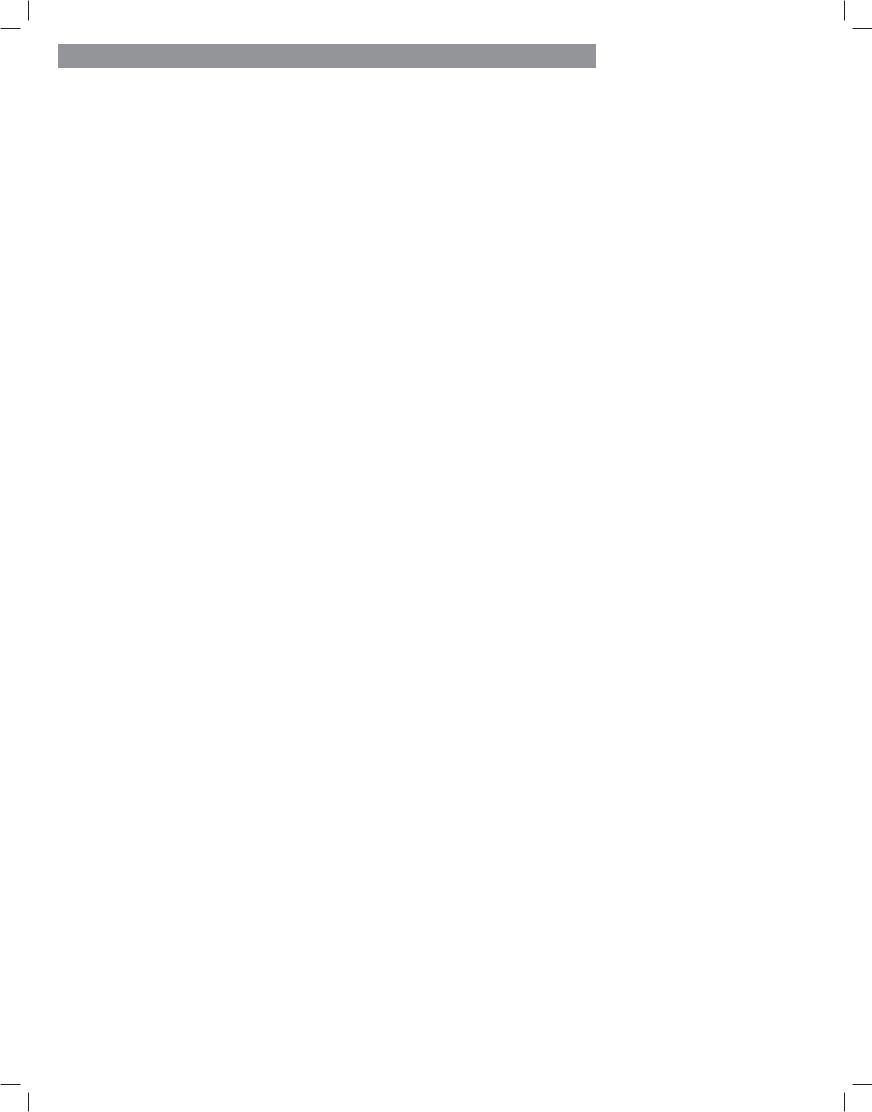
IMPORTANT SAFETY INSTRUCTIONS
BASIC SAFETY PRECAUTIONS
 WARNING: To reduce the risk of fire, electric shock, or injury to persons when using this appliance, follow basic precautions, including the following:
WARNING: To reduce the risk of fire, electric shock, or injury to persons when using this appliance, follow basic precautions, including the following:
•Read all instructions before using the dryer.
•Before use, the dryer must be properly installed, as described in this manual.
•Do not place items exposed to cooking oils in your dryer. Items contaminated with cooking oils may contribute to a chemical reaction that could cause a load to catch fire.
•Do not dry articles that have been previously cleaned in, washed in, soaked in, or spotted with gasoline, dry-cleaning solvents, or other flammable or explosive substances, as they give o vapors that could ignite or explode.
•Do not reach into the dryer if the drum or any other part is moving.
•Do not repair or replace any part of the dryer or attempt any servicing unless specifically recommended in this Use and Care Guide or in published user-repair instructions that you understand and have the skills to carry out.
•Do not tamper with controls.
•Before the dryer is removed from service or discarded, remove the door to the drying compartment.
•Do not allow children to play on or in the dryer. Close supervision of children is necessary when the dryer is used near children.
•Do not use fabric softeners or products to eliminate static unless recommended by the manufacturer of the fabric softener or product.
•Do not use heat to dry articles containing foam rubber or similarly textured rubber-like materials.
•Keep the area around the exhaust opening and adjacent surrounding areas free from the accumulation of lint, dust, and dirt.
•The interior of the dryer and exhaust vent should be cleaned periodically by qualified service personnel.
•Do not install or store the dryer where it will be exposed to the weather.
•Always check the inside of the dryer for foreign objects.
•Clean the lint filter before or after each load.
•Do not store plastic, paper, or clothing that may burn or melt on top of the dryer during operation.
 WARNING: This product contains chemicals known to the State of California to cause cancer and birth defects or other reproductive harm. Wash hands after handling.
WARNING: This product contains chemicals known to the State of California to cause cancer and birth defects or other reproductive harm. Wash hands after handling.
CALIFORNIA SAFE DRINKING WATER AND TOXIC ENFORCEMENT ACT
This act requires the Governor of California to publish a list of substances known to the state to cause cancer, birth defects, or other reproductive harm and requires businesses to warn customers of potential exposure to such
substances. Gas appliances can cause minor exposure to four of these substances, namely benzene, carbon monoxide, formaldehyde, and soot, caused primarily by the incomplete combustion of natural gas or LP fuels.
Properly adjusted dryers will minimize incomplete combustion. Exposure to these substances can be minimized further by properly venting the dryer to the outdoors.
GROUNDING REQUIREMENTS
This appliance must be grounded. In the event of malfunction or breakdown, grounding will reduce the risk of electric shock by providing a path of least resistance for electric current. This appliance must be equipped with a cord having an equipment-grounding conductor and a grounding plug. The plug must be plugged into an appropriate outlet that is properly installed and grounded in accordance with all local codes and ordinances.
 WARNING: Improper connection of the equipment-grounding conductor can result in a risk of electric shock. Check with a qualified electrician or service person if you are in doubt as to whether the appliance is properly grounded. Do not modify the plug provided with the appliance. If it will not fit the outlet, have a proper outlet installed by a qualified electrician. This appliance must be connected to a grounded metal, permanent wiring system or an equipment grounding conductor must be run with the circuit conductors and connected to the equipment grounding terminal or lead on the appliance. Electrical shock can result if the dryer is not properly grounded.
WARNING: Improper connection of the equipment-grounding conductor can result in a risk of electric shock. Check with a qualified electrician or service person if you are in doubt as to whether the appliance is properly grounded. Do not modify the plug provided with the appliance. If it will not fit the outlet, have a proper outlet installed by a qualified electrician. This appliance must be connected to a grounded metal, permanent wiring system or an equipment grounding conductor must be run with the circuit conductors and connected to the equipment grounding terminal or lead on the appliance. Electrical shock can result if the dryer is not properly grounded.
4
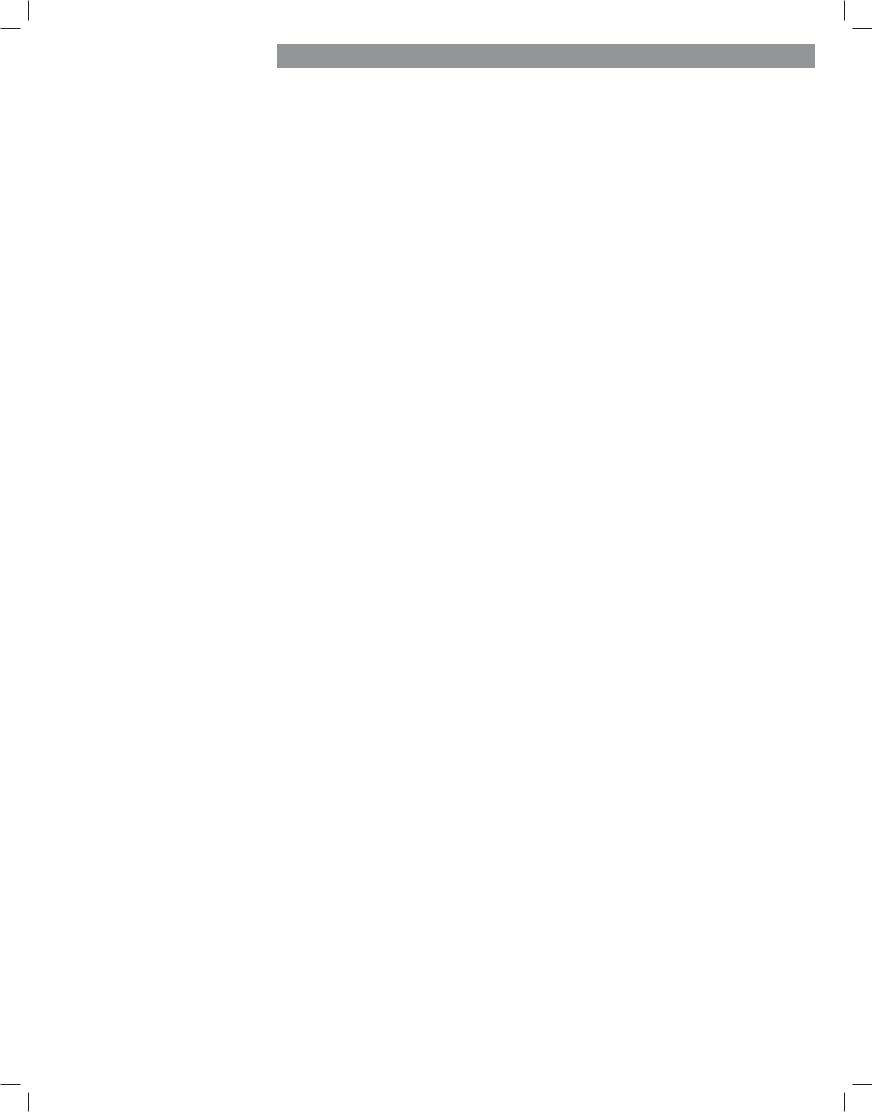
IMPORTANT SAFETY INSTRUCTIONS
SAFETY INSTRUCTIONS FOR INSTALLATION
 WARNING: To reduce the risk of fire, electric shock, or injury to persons when using this appliance, follow basic precautions, including the following:
WARNING: To reduce the risk of fire, electric shock, or injury to persons when using this appliance, follow basic precautions, including the following:
•Properly ground dryer to conform with all governing codes and ordinances. Follow details in the installation instructions. Electrical shock can result if the dryer is not properly grounded.
•Before use, the dryer must be properly installed as described in this manual. Electrical shock can result if the dryer is not properly grounded.
•Install and store the dryer where it will not be exposed to temperatures below freezing or exposed to
the weather.
•All repairs and servicing must be performed by an authorized service technician unless specifically recommended in this Owner’s Guide. Use only authorized factory parts. Failure to follow this warning can cause serious injury, fire, electrical shock, or death.
•To reduce the risk of electrical shock, do not install the dryer in humid spaces. Failure to follow this warning can cause serious injury, fire, electrical shock, or death.
•Connect to a properly rated, protected, and sized power circuit to avoid electrical overload. Improper power circuits can melt, creating risk of electrical shock and/or fire hazard.
•Remove all packing items and dispose of all shipping materials properly. Failure to do so can result in death, fire, explosion, burns, or death.
•Place dryer at least 18 inches above the floor for a garage installation. Failure to do so can result in fire, explosion, burns, or death.
•Keep all packaging from children. Packaging material can be dangerous for children. There is a risk of su ocation.
•Do not install near items that produce heat or open
flame such as stoves or cooking ovens. Failure to follow this warning can cause product deformation, smoke and fire.
•Do not place candles, smoking materials, or other flammables on top of the product. Dripping wax, smoke, or fire can result.
•Remove all protective vinyl film from the product. Failure to do so can cause product damage, smoke or fire.
Exhaust/Ducting:
•Gas dryers MUST be exhausted to the outside. Failure to follow these instructions can result in fire or death.
•The dryer exhaust system must be exhausted to the outside of the dwelling. If the dryer is not exhausted outdoors, some fine lint and large amounts of moisture will be expelled into the laundry area. An accumulation of lint in any area of the home can create a health and fire hazard.
•Use only rigid metal or flexible metal 4 inch diameter duct inside the dryer cabinet or for exhausting to the outside. Use of plastic or other combustible ductwork can cause a fire. Punctured ductwork can cause a fire if it collapses or becomes otherwise restricted in use or during installation.
•Ductwork is not provided with the dryer, and you should obtain the necessary ductwork locally. The end cap should have hinged dampers to prevent backdraft when the dryer is not in use. Failure to follow these instructions can result in fire or death.
•The exhaust duct must be 4 inches (10.2 cm) in diameter with no obstructions. The exhaust duct should be kept as short as possible. Make sure to clean any old ducts before installing your new dryer. Failure to follow these instructions can result in fire or death.
•Rigid or semi rigid metal ducting is recommended for use between the dryer and the wall. In special
installations when it is impossible to make a connection with the above recommendations, a UL listed flexible metal transition duct may be used between the dryer and wall connection only. The use of this ducting will a ect drying time. Failure to follow these instructions can result in fire or death.
•DO NOT use sheet metal screws or other fasteners which extend into the duct that could catch lint and reduce the e ciency of the exhaust system. Secure all joints with duct tape. For complete details, follow the Installation Instructions. Failure to follow these instructions can result in fire or death.
5
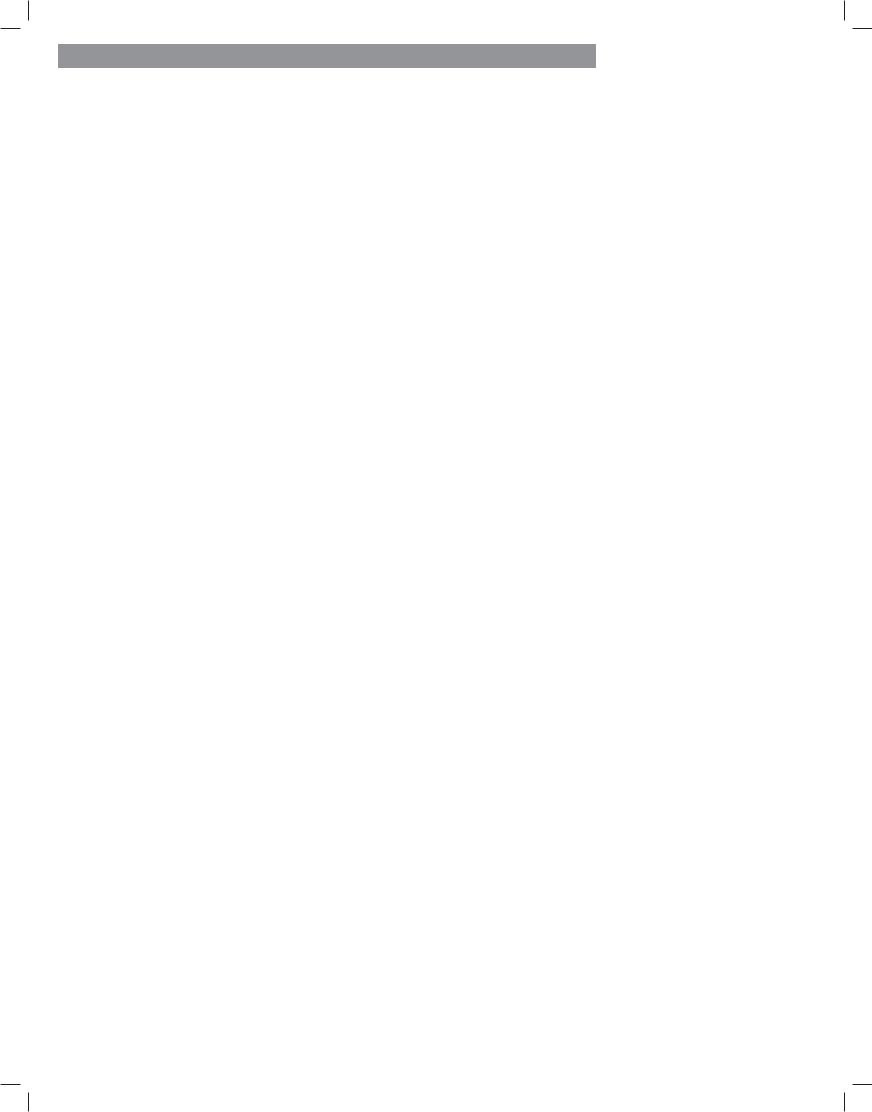
IMPORTANT SAFETY INSTRUCTIONS
SAFETY INSTRUCTIONS FOR CONNECTING ELECTRICITY
 WARNING: To reduce the risk of fire, electric shock, or injury to persons when using this appliance, follow basic precautions, including the following:
WARNING: To reduce the risk of fire, electric shock, or injury to persons when using this appliance, follow basic precautions, including the following:
•Do not, under any circumstances, cut or remove the ground prong from the power cord. To prevent personal injury or damage to the dryer, the electrical power cord must be plugged into a properly
grounded outlet.
•For personal safety, this dryer must be properly grounded. Failure to do so can result in electrical shock or injury.
•Refer to the installation instructions in this manual for specific electrical requirements for your model. Failure to follow these instructions can create an electrical shock hazard and/or a fire hazard.
•This dryer must be plugged into a properly grounded outlet. Electrical shock can result if the dryer is not properly grounded. Have the wall outlet and circuit checked by a qualified electrician to make sure the outlet is properly grounded. Failure to follow these instructions can create an electrical shock hazard and/or a fire hazard.
•The dryer should always be plugged into its own individual electrical outlet which has a voltage rating that matches the rating plate. This provides the best performance and also prevents overloading house wiring circuits which could cause a fire hazard from overheated wires.
•Never unplug your dryer by pulling on the power cord. Always grip the plug firmly and pull straight out from the outlet. The power cord can be damaged, resulting in a risk of fire and electrical shock.
•Repair or replace immediately all power cords that have become frayed or otherwise damaged. Do not use a cord that shows cracks or abrasion damage along its length or at either end. The power cord can melt, creating electrical shock and/or fire hazard.
•When installing or moving the dryer, be careful not to pinch, crush, or damage the power cord. This will prevent injury and prevent damage to the dryer from fire and electrical shock.
SAVE THESE INSTRUCTIONS
6

FEATURES AND BENEFITS
 KEY PARTS AND COMPONENTS
KEY PARTS AND COMPONENTS
There are several important components that are referenced in this manual.
AEASY-TO-USE CONTROL PANEL
Select the desired dry cycle, add cycle options or adjust settings with the touch of a button.
BTIME AND STATUS DISPLAY
The easy-to-read LED display shows cycle status and estimated time remaining.
CCYCLE MODIFIERS
Adjust the cycle defaults such as temperature and dry level with the touch of a button.
NOTE: Not all settings are available for all cycles.
DCHECK VENT
(Duct Blockage Sensing System)
The CHECK VENT (Duct blockage sensing system) detects and alerts you to blockages in the exhaust system that reduce airflow from the dryer.
Maintaining clean exhaust system ducts improves operating e ciency and helps minimize service calls, saving you money.
ELARGE CAPACITY STEEL DRUM WITH DRUM LIGHT
The ultra-large, oxidation-resistant, coated steel drum o ers superior durability. The light comes on when the door is opened.
A D B
C
F
E |
G |
|
|
|
H |
Terminal |
Power cord |
block |
location |
access panel |
(Gas |
(Electric |
models) |
models) |
|
FEASY-ACCESS REVERSIBLE DOOR
The wide-opening, see-through glass door provides easy access for loading and unloading. Door swing can be reversed to adjust for installation location.
GFRONT-MOUNT LINT FILTER
The front-mount lint filter allows for easy access and cleaning between loads.
HLEVELING FEET
Four leveling feet (two in front, and two in back) adjust to improve dryer stability on uneven floors.
 ACCESSORIES
ACCESSORIES
Included Accessories |
Optional Accessories |
|
(sold separately) |
Safety tether kit |
Drying rack** |
|
Part No. 3750EL0001C |
Required Accessories |
|
(sold separately) |
|
Water Inlet
 Valve
Valve
Gas |
|
|
connection |
|
|
location |
Exhaust |
|
(Gas models) |
||
duct |
||
|
||
|
outlet |
Rear of Dryer
Two-Way Reversible Door
release
hamper door
swing door 





The two-way reversible door feature allows you to open the dryer door from the top, hamper-style, when loading the dryer to help guide clothes into the drum and prevent them from falling onto the floor. When unloading the dryer or loading bulkier items, use the swing door for easy access to the drum.
|
Side vent kit* |
|
|
Kit No. 26-49670 |
|
Hoses and Y connector* |
* at Sears.com |
|
Kit No. 26-59029 |
||
** at SearsPartsDirect.com |
||
|
7 |
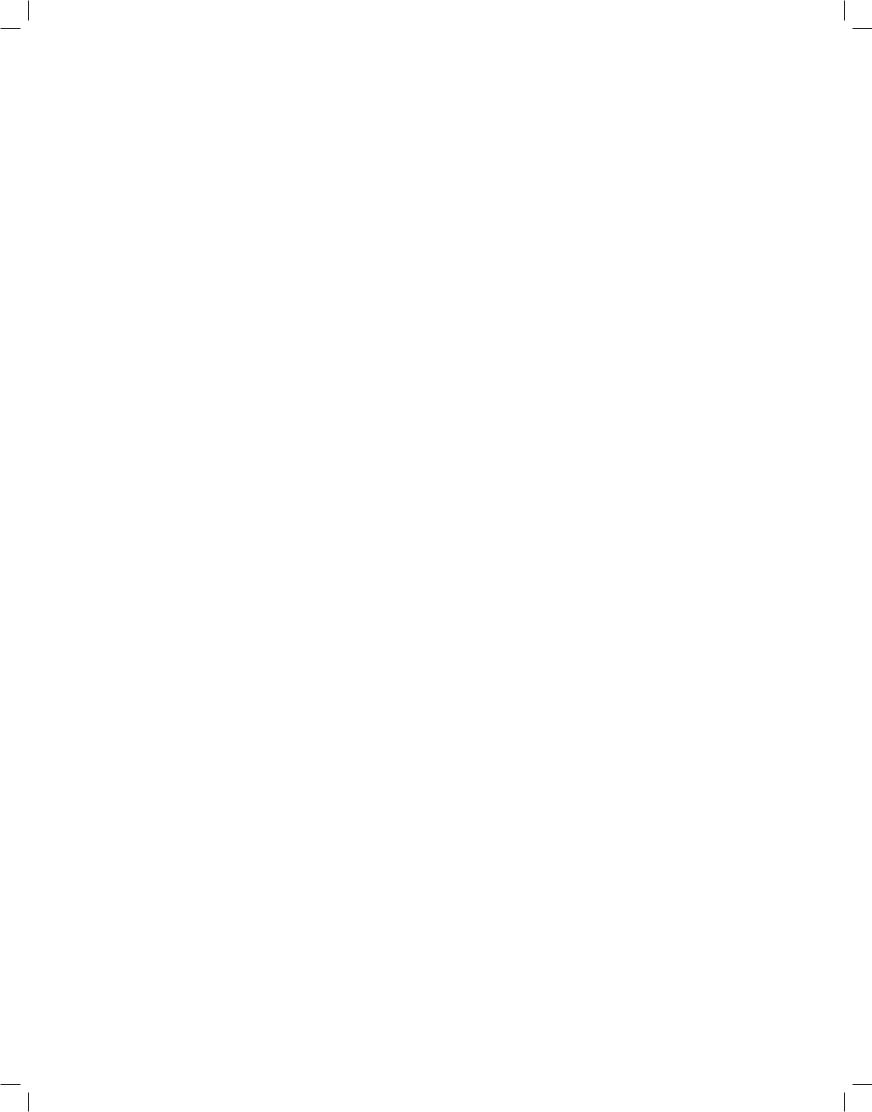
|
|
|
|
INSTALLATION INSTRUCTIONS |
||
|
|
|
KEY DIMENSIONS AND SPECIFICATIONS |
|||
|
|
|
||||
|
|
|
|
|
|
|
|
|
Description Dryer |
Steam Dryer (Gas and Electric) |
|
|
|
|
|
Electrical Requirements |
Refer to the rating label |
|
|
|
|
|
Gas Requirements* NG: |
4–10.5 inches WC |
|
|
|
|
|
Gas Requirements* LP: |
8–13 inches WC |
|
|
|
|
|
Dimensions |
27 in. (W) X 29 ½ in. (D) X 40 3/16 in. (H), 50 ¼ in. (D with door open) |
|
||
|
|
|
|
68.6 cm (W) X 75 cm (D) X 102 cm (H), 127.5 cm (D with door open) |
|
|
|
|
Net Weight |
Electric : 135.1 lb. (61.3 kg) Gas : 137.8 lb. (62.5 kg) |
|
|
|
|
|
Drying Capacity |
IEC 7.3 cu.ft. (22.5 lb/10.2 kg) |
|
||
|
|
|
|
|
|
|
|
|
*Gas Models Only |
|
|
|
|
 LOCATION REQUIREMENTS
LOCATION REQUIREMENTS
IMPORTANT: Read all installation instructions completely before installing and operating your dryer.
It is important that you review this entire manual before installing and using your dryer. It contains detailed instructions concerning electrical connections, gas connections and exhaust requirements.
CHOOSE THE PROPER LOCATION
•A location that allows for proper exhaust installation. A gas dryer must be exhausted to the outdoors. See
Venting the Dryer.
•A grounded electrical outlet located within 2 ft. (61 cm) of either side of the dryer. See Connecting Electric
Dryers.
•A sturdy floor to support the total dryer weight of 200 lbs (90.7 kg). The combined weight of a companion appliance should also be considered.
•No other fuel-burning appliance can be installed in the same closet as a dryer.
•Store and install the dryer where it will not be exposed to temperatures below freezing or exposed to outdoor weather conditions.
•Choose a location with a solid, level floor with a maximum slope of 1 inch (2.5 cm) under the entire dryer. If the slope is greater than 1 inch (2.5 cm), install the Extended Dryer Feet Kit. Clothes may not tumble properly, and automatic sensor cycles may not operate correctly if the dryer is not level.
•If the dryer is being installed in a garage, place the dryer at least 18 inches (45.7cm) above the floor. If using a pedestal, you will need 18 inches (46 cm) to the bottom of the dryer.
•To reduce the risk of electric shock, do not install the dryer in damp or wet locations.
Do not operate your dryer at temperatures below 45°F (7°C). At lower temperatures, the dryer might not shut o at the end of an automatic cycle. This can result in longer drying times. The dryer must not be installed or stored
in an area where it will be exposed to water and/or weather. Check code requirements. Some codes limit, or do not permit, installation of the dryer in garages, closets, mobile homes or sleeping quarters. Contact your local building inspector.
NOTE: Installing the dryer in a humid space, or installing or storing the dryer where it will be exposed to the weather or freezing temperatures, may result in rust
or other damage that is not covered by the product warranty.
IMPORTANT: If you are installing your dryer in a manufactured or mobile home, please refer to the
Special Electrical Requirements for Mobile or Manufactured Homes section.
 CLEARANCES
CLEARANCES
•Most installations require a minimum 5 ½ inch (14 cm) clearance behind the dryer for the exhaust ducting.
•Allow minimum clearances of at least 1 inch (2.5 cm) on the sides and back to minimize vibration and noise.
•Allowing additional clearance for installation and servicing is recommended.
•Be sure to allow for wall, door, or floor moldings that may increase the required clearances.
•Allow at least 21 inches (53.3 cm) in front of the dryer to open the door.
8
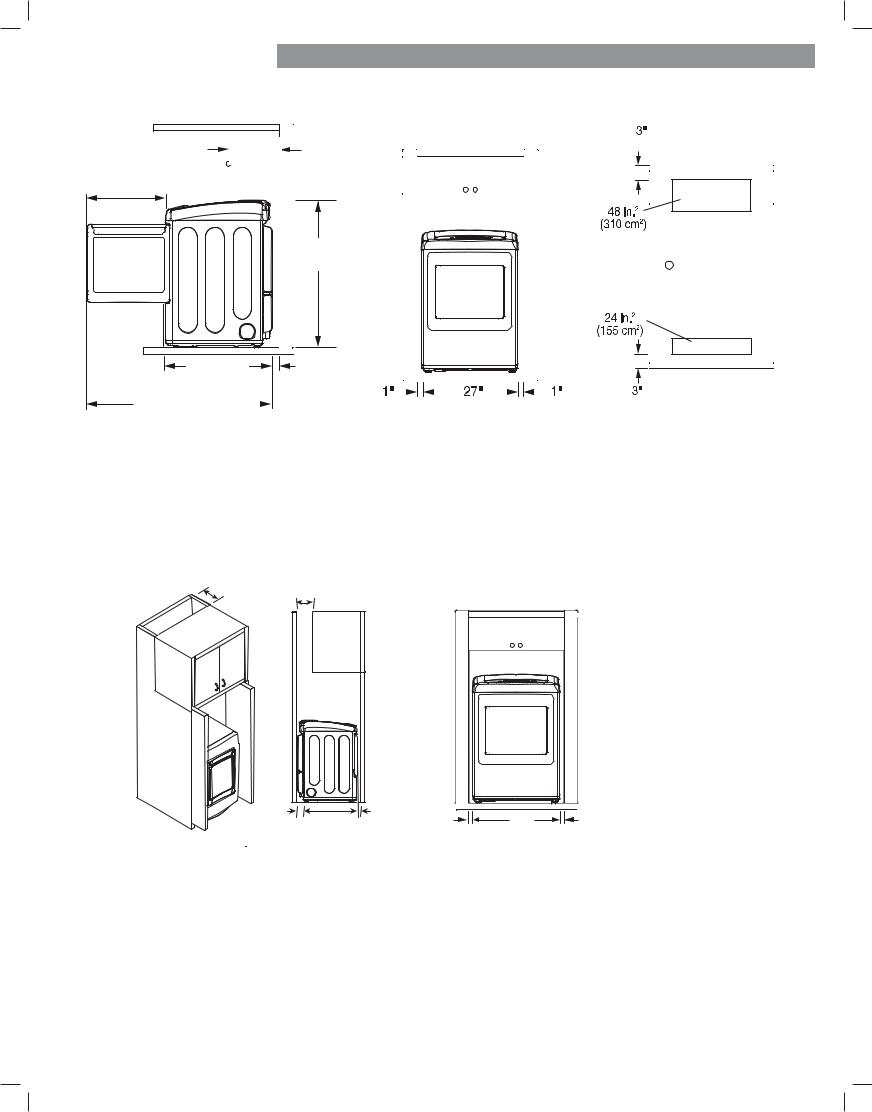
INSTALLATION INSTRUCTIONS
 CLEARANCES (continued)
CLEARANCES (continued)
|
14 " max.* |
(7.6 cm) |
|
|
(35.6 |
cm) |
|
21 |
1 /4" |
|
|
(54 cm) |
|
|
|
|
|
|
40 3/16 " |
|
|
|
(102 cm) |
|
29 1/2 " |
|
5"** |
|
(75 cm) |
|
(12.7 cm) |
|
|
|
|
50 1 /4" |
|
|
|
|
|
|
|
|
|
|
(7.6 cm) |
|
(2.54 cm) |
(68.6 cm) |
(2.54 cm) |
||||||||
|
|||||||||||
(127.5 cm) |
|
|
|
|
|
|
|
|
|
|
|
Closet Door Vent Requirements
Additional instructions for closet installations:
The closet door must allow for su cient airflow. Refer to the diagram above for minimum vent opening requirements. A louvered door is also acceptable.
7"* (17.8 cm) |
7"* (17.8 cm) |
|
5"* |
29 ½" |
1"* |
(12.7 cm) |
(75 cm) (2.5 cm) |
|
1" |
27 " |
1" |
(2.54 cm) |
(68.6 cm) |
(2.54 cm) |
Recommended installation spacing for cabinet installation:
For cabinet installation with a door, minimum ventilation openings in the top of the cabinet are required.
*Required spacing
**For side or bottom venting,
2-inch (5.1 cm) clearance is allowed.
9

INSTALLATION INSTRUCTIONS
 GAS DRYERS
GAS DRYERS
GAS REQUIREMENTS (GAS MODELS ONlY)
 WARNING: To reduce the risk of fire, electric shock, or injury to persons when using this appliance,
WARNING: To reduce the risk of fire, electric shock, or injury to persons when using this appliance,
follow basic precautions, including the following: |
|
|
• Gas supply requirements: As shipped from the factory, |
• Connect the dryer to the type of gas shown on the |
|
this dryer is configured for use with natural gas (NG). |
nameplate. Failure to do so can result in fire, explosion, |
|
It can be converted for use with propane (LP) gas. Gas |
or death. |
|
pressure must not exceed 8 inches water column for |
• To prevent contamination of the gas valve, purge the |
|
(NG), or 13 inches water column for (LP). |
||
gas supply of air and sediment before connecting |
||
• A qualified service or gas company technician must |
||
the gas supply to the dryer. Before tightening the |
||
connect the dryer to the gas service. Failure to follow |
connection between the gas supply and the dryer, |
|
these instructions can result in fire, explosion, or death. |
purge remaining air until the odor of gas is detected. |
|
• Isolate the dryer from the gas supply system by closing |
Failure to do so can result in fire, explosion, or death. |
|
|
||
its individual manual shuto valve during any pressure |
• DO NOT use an open flame to inspect for gas leaks. |
|
testing of the gas supply. Failure to do so can result in |
Use a noncorrosive leak detection fluid. Failure to do so |
|
fire, explosion, or death. |
can result in fire, explosion, or death. |
|
• Supply line requirements: Your laundry room must |
• Use only a new AGAor CSA-certified gas supply line |
|
have a rigid gas supply line to your dryer. In the United |
with flexible stainless steel connectors. Failure to do so |
|
States, an individual manual shuto valve MUST be |
can result in fire, explosion, or death. |
|
installed within at least 6 ft. (1.8 m) of the dryer, in |
• Securely tighten all gas connections. Failure to do so |
|
accordance with the National Fuel Gas Code ANSI |
||
can result in fire, explosion, or death. |
||
Z223.1 or Canadian gas installation code CSA B149.1. A |
||
|
||
⅛ inch NPT pipe plug must be installed. Failure to do |
• Use Teflon tape or a pipe-joint compound that is |
|
so can result in fire, explosion, or death. |
insoluble in propane (LP) gas on all pipe threads. |
|
• If using a rigid pipe, the rigid pipe should be ½ inch |
Failure to do so can result in fire, explosion, |
|
or death. |
||
IPS. If acceptable under local codes and ordinances |
||
|
||
and when acceptable to your gas supplier, ⅜ inch |
• DO NOT attempt any disassembly of the dryer; |
|
approved tubing may be used where lengths are less |
disassembly requires the attention and tools of an |
|
than 20 ft. (6.1 m). Larger tubing should be used for |
authorized and qualified service technician or company. |
|
lengths in excess of 20 ft. (6.1 m). Failure to do so can |
Failure to follow this warning can result in fire, explosion, |
|
result in fire, explosion, or death. |
or death. |
ELECTRICAL REQUIREMENTS (GAS MODELS ONLY)
•Do not, under any circumstances, cut or remove the third (ground) prong from the power cord. Failure to follow this warning can result in fire, explosion, or death.
•For personal safety, this dryer must be properly grounded. Failure to follow this warning can result in fire, explosion, or death.
•The power cord of this dryer is equipped with a 3-prong (grounding) plug which mates with a standard 3-prong (grounding) wall outlet to minimize the possibility of electric shock hazard from this appliance.
Failure to follow this warning can result in fire, explosion, or death.
•This dryer must be plugged into a 120-VAC, 60-Hz. grounded outlet protected by a 15-ampere fuse or circuit breaker. Failure to follow this warning can result in fire, explosion, or death.
•Where a standard 2-prong wall outlet is encountered, it is your personal responsibility and obligation to have it replaced with a properly grounded 3-prong wall outlet.
Failure to follow this warning can result in fire, explosion, or death.
3-prong grounding type wall receptacle
Ensure proper ground exists before use.
3-prong grounding
plug
10
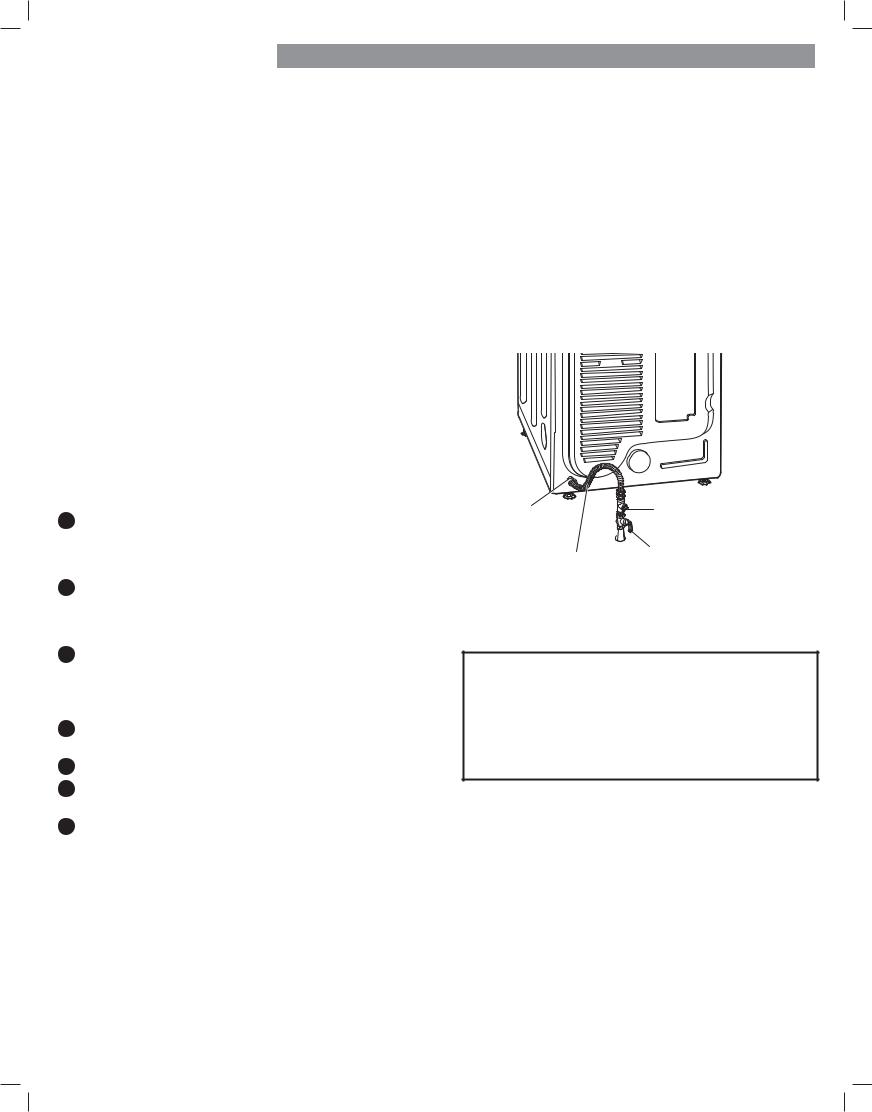
INSTALLATION INSTRUCTIONS
 GAS DRYERS (continued)
GAS DRYERS (continued)
 WARNING: To reduce the risk of fire, electric shock, or injury to persons when using this appliance, follow basic precautions, including the following:
WARNING: To reduce the risk of fire, electric shock, or injury to persons when using this appliance, follow basic precautions, including the following:
• Installation and service must be performed by a |
• If necessary, the correct nozzle (for the LP nozzle kit, |
|
qualified installer, service agency, or the gas supplier. |
order part number 17025) should be installed by a |
|
Failure to do so can result in fire, explosion, or death. |
qualified technician and the change should be noted on |
|
• Use only a new stainless steel flexible connector and a |
the dryer. Failure to do so can result in fire, explosion, or |
|
death. |
||
new AGA-certified connector. Failure to do so can result |
||
• All connections must be in accordance with local codes |
||
in fire, explosion, or death. |
||
• A gas shuto valve must be installed within 6 ft. |
and regulations. Failure to do so can result in fire, |
|
explosion, or death. |
||
(1.8 m) of the dryer. Failure to do so can result in fire, |
||
• Gas dryers MUST exhaust to the outdoors. Failure to do |
||
explosion, or death. |
||
• The dryer is configured for natural gas when shipped |
so can result in fire, explosion, or death. |
|
|
||
from the factory. Make sure that the dryer is equipped |
|
|
with the correct burner nozzle for the type of gas being |
|
|
used (natural gas or propane gas). Failure to do so can |
|
|
result in fire, explosion, or death. |
|
CONNECTING THE GAS SUPPLY
NOTE: This dryer is configured from the factory set for natural gas (NG). If dryer is to be used with propane (LP) gas, it must be converted by a qualified
service technician.
1Make sure that the gas supply to the laundry room is turned OFF and the dryer is unplugged. Confirm that the type of gas available in your laundry room is appropriate for the dryer.
2Remove the shipping cap from the gas fitting at the back of the dryer. Be careful not to damage the threads of the gas connector when removing the shipping cap.
3Connect the dryer to your laundry room’s gas supply using a new flexible stainless steel connector with a ⅜-inch NPT fitting.
NOTE: DO NOT use old connectors.
4Securely tighten all connections between the dryer and your laundry room’s gas supply.
5Turn on your laundry room’s gas supply.
6Check all pipe connections (both internal and external) for gas leaks with a noncorrosive leak-detection fluid.
7Proceed to Venting the Dryer (refer to pages 14-15).
3/8" NPT Gas |
1/8" NPT Pipe Plug |
|
|
Connection |
|
Gas Supply $*$ &6$ &HUWLoHG 6KXWRç 9DOYH
Stainless Steel Flexible Connector
High-Altitude Installations
The BTU rating of this dryer is AGA-certified for elevations below 10,000 feet.
If your gas dryer is being installed at an elevation above 10,000 feet, it must be derated by a qualified technician or gas supplier.
11
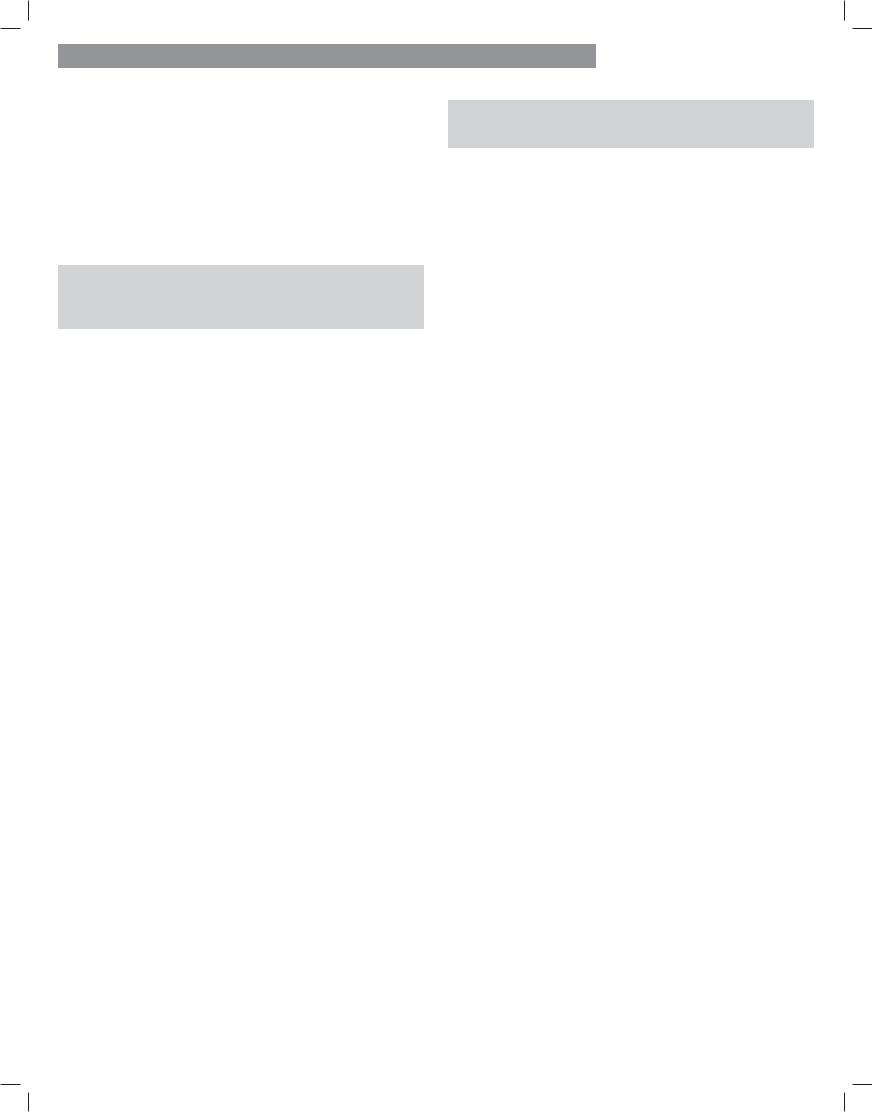
INSTALLATION INSTRUCTIONS
 ELECTRIC DRYERS ELECTRICAL REQUIREMENTS
ELECTRIC DRYERS ELECTRICAL REQUIREMENTS
 WARNING: To help prevent fire, electrical shock, serious injury, or death, the wiring and grounding must conform to the latest edition of
WARNING: To help prevent fire, electrical shock, serious injury, or death, the wiring and grounding must conform to the latest edition of
the National Electrical Code, ANSI/NFPA 70 and all applicable local regulations. Please contact a qualified electrician to check your home’s wiring and fuses to ensure that your home has adequate electrical power to operate the dryer.
Special Electrical Requirements for Mobile or Manufactured Homes
 WARNING: To reduce the risk of fire, electric shock, or injury to persons when using this appliance, follow basic precautions, including the following:
WARNING: To reduce the risk of fire, electric shock, or injury to persons when using this appliance, follow basic precautions, including the following:
•Any installation in a manufactured or mobile home must comply with the Manufactured Home Construction and Safety Standards Title 24 CFR, Part 32-80 or Standard CAN/CSA0Z240 MH and local codes and ordinances.
•A 4-wire connection is required for all mobile and manufactured home installations, as well as all new construction after January 1, 1996. Failure to do so can result in fire, explosion, or death.
•A gas dryer must be permanently attached to the floor.
•To reduce the risk of combustion and fire, the dryer must be vented to the outside.
•DO NOT vent the dryer under a manufactured home or mobile home.
•Electric dryers may be vented to the outside using the back, left, right, or bottom panel.
•Gas dryers may be vented to the outside using the back, left, or bottom panel. Gas dryers may not be vented
to the outside using the right side panel because of the burner housing.
•The dryer exhaust duct must be a xed securely to the manufactured or mobile home structure, and the exhaust duct must be made of a material that will resist fire and combustion. It is recommended that you use a rigid or flexible metal duct.
•DO NOT connect the dryer exhaust duct to any other duct, vent, chimney, or other exhaust duct.
•Make sure the dryer has adequate access to outside fresh air to ensure proper operation. The opening for outside fresh air must be at least 25 in2 (163 cm2).
•It is important that the clearance of the duct from any combustible construction be at least 2 inches (5 cm), and when venting the dryer to the outdoors, the dryer can be installed with a clearance of 1 inch (2.5 cm) at the sides and back of the dryer.
•Please be aware that venting materials are not supplied with the dryer. You should obtain the venting materials necessary for proper installation.
Electrical Requirements for Electric Models Only
 WARNING: To reduce the risk of fire, electric shock, or injury to persons when using this appliance, follow basic precautions, including the following:
WARNING: To reduce the risk of fire, electric shock, or injury to persons when using this appliance, follow basic precautions, including the following:
•This dryer must be connected to a grounded metal, permanent wiring system, or an equipment grounding conductor must be run with the circuit conductors and connected to the equipment grounding terminal or lead on the dryer. Failure to do so can result in fire, explosion, or death.
•The dryer has its own terminal block that must be connected to a separate 240 VAC, 60-Hertz, single phase circuit, fused at 30 amperes (the circuit must be fused on both sides of the line). ELECTRICAL SERVICE FOR THE DRYER SHOULD BE OF THE MAXIMUM RATE VOLTAGE LISTED ON THE NAMEPLATE. DO NOT CONNECT DRYER TO 110-, 115-, OR 120-VOLT CIRCUIT. Failure to follow these instructions can result in fire, explosion, or death.
•If branch circuit to dryer is 15 ft. (4.5 m) or less in length, use UL (Underwriters Laboratories) listed No.- 10 AWG wire (copper wire only), or as required by local codes. If over 15 ft. (4.50 m), use UL-listed No.-8 AWG wire (copper wire only), or as required by local codes. Allow su cient slack in wiring so dryer can be moved from its normal location when necessary.
Failure to do so can result in fire, explosion, or death.
•The power cord (pigtail) connection between wall receptacle and dryer terminal block IS NOT supplied with the dryer. Type of pigtail and gauge of wire must conform to local codes and with instructions on the following pages. Failure to follow these instructions can result in fire, explosion, or death
•A 4-wire connection is required for all new construction after January 1, 1996. A 4-wire connection must be used where local codes do not permit grounding through the neutral wire. Failure to do so can result in fire, explosion, or death.
12
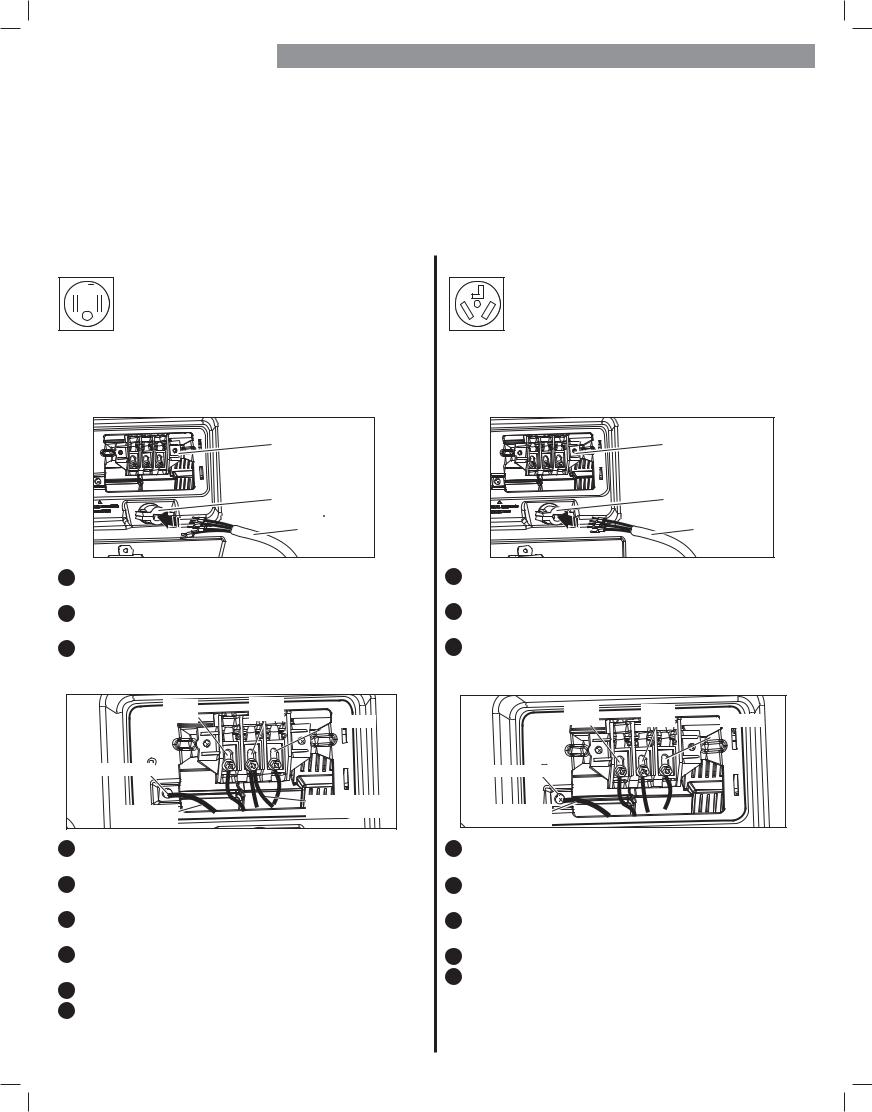
 ELECTRIC DRYERS (continued) CONNECTING ELECTRIC DRYERS
ELECTRIC DRYERS (continued) CONNECTING ELECTRIC DRYERS
 WARNING:
WARNING:
Connect the power cord to the terminal block. Each colored wire should be connected to the terminal block screw with the same color wire around it. For example, connect the black power cord wire to the terminal block screw with the black wire around it. Failure to follow these instructions may result in a short or overload.
Four-Wire Power Cord
• A 4-wire connection is required for all mobile 


 and manufactured home installations, as well
and manufactured home installations, as well 

 as all new construction after January 1, 1996.
as all new construction after January 1, 1996.
•A UL-listed strain relief is required.
•Use a 30-amp, 240-volt, 4-wire, UL-listed power cord with #10 AWG-minimum copper conductor and closed loop or forked terminals with upturned ends.
Terminal |
Block |
UL-Listed |
Strain Relief |
UL-Listed 4-Wire |
Power Cord |
1Remove the terminal block access cover on the upper back of the dryer.
2Install a UL-listed strain relief into the power cord through-hole.
3Thread a 30-amp, 240-volt, 4-wire, UL-listed power cord with #10 AWG-minimum copper conductor through the strain relief.
Hot |
Neutral |
(Black) |
(White) |
|
Hot (Red) |
Ground Screw |
|
Power Cord |
White wire moved |
from ground screw |
|
Ground Wire |
|
4Transfer the dryer’s ground wire from behind the green ground screw to the center screw of the terminal block.
5Attach the two hot leads of the power cord to the outer terminal block screws.
6Attach the white neutral wire to the center screw of the terminal block.
7Attach the power cord ground wire to the green ground screw.
8TIGHTEN ALL SCREWS SECURELY.
9Reinstall the terminal block access cover.
INSTALLATION INSTRUCTIONS
Grounding through the neutral conductor is prohibited for: (1) new branch-circuit installations, (2) mobile homes, (3) recreational vehicles, and (4) areas where local codes prohibit grounding through the neutral conductor.
Three-Wire Power Cord
• A 3-wire connection is NOT permitted on new construction after January 1, 1996.
• A UL-listed strain relief is required.
•Use a 30-amp, 240-volt, 3-wire, UL-listed power cord with #10 AWG-minimum copper conductor and closed loop or forked terminals with upturned ends.
Terminal |
Block |
UL-Listed |
Strain Relief |
UL-Listed 3-Wire |
Power Cord |
1Remove the terminal block access cover on the upper back of the dryer.
2Install a UL-listed strain relief into the power cord through-hole.
3Thread a 30-amp, 240-volt, 3-wire, UL-listed power cord with #10 AWG-minimum copper conductor through the strain relief.
Hot |
Neutral |
|
(Black) |
(White) |
Hot (Red) |
Ground Screw |
|
|
White wire from |
|
|
dryer harness |
|
|
4Attach the two hot leads (black and red) of the power cord to the outer terminal block screws.
5Attach the neutral (white) wire to the center terminal block screw.
6Connect the external ground (if required by local codes) to the green ground screw.
7TIGHTEN ALL SCREWS SECURELY.
8Reinstall the terminal block access cover.
13
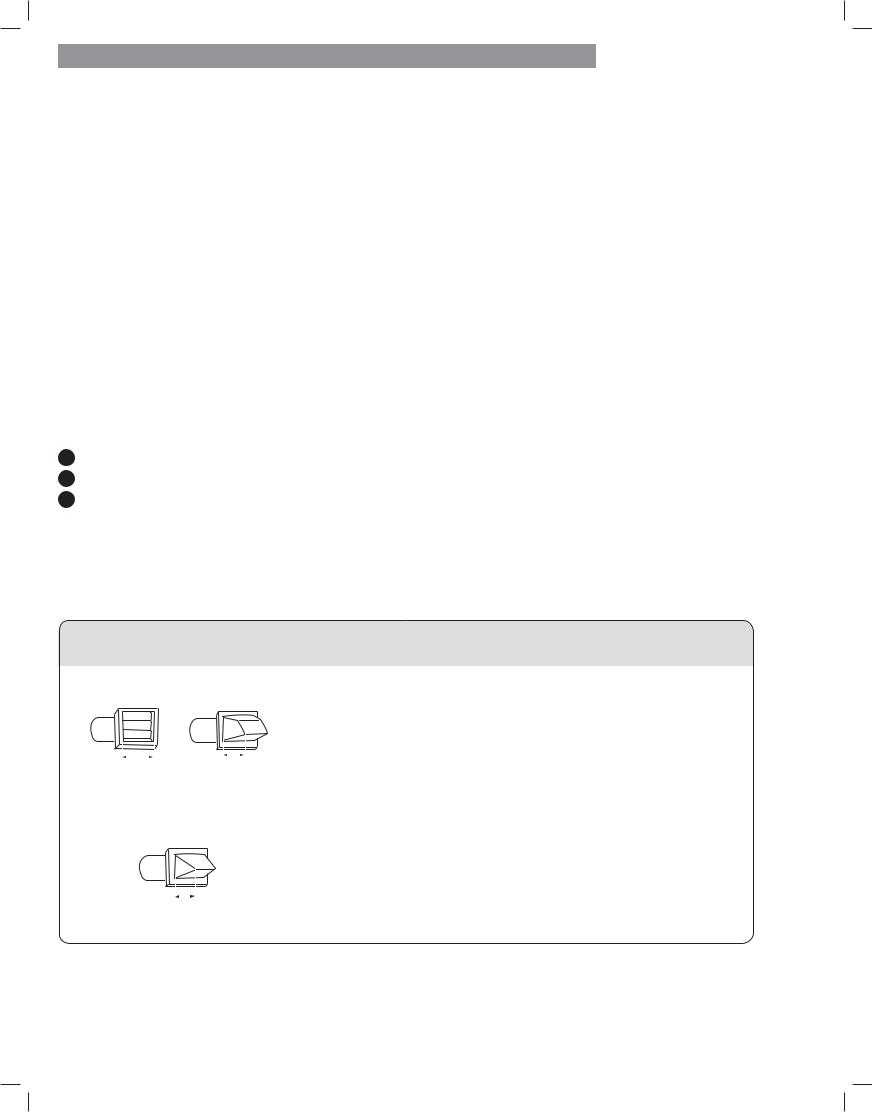
INSTALLATION INSTRUCTIONS
 VENTING THE DRYER
VENTING THE DRYER
IMPORTANT! CHECK YOUR EXHAUST SYSTEM FOR PROBLEMS
The most common cause of dryer problems is poor exhaust venting. Before installing your new dryer, check the items listed below to make sure you get the best possible performance. This can save you time and money by reducing cycle times and increasing energy e ciency.
•DIRTY OR DAMAGED EXHAUST DUCTS. Lint builds up in exhaust ducts over time. This decreases the airflow and makes the dryer work harder. Visually inspect your ducts from both ends and have them cleaned if they have not been cleaned recently.
•WRONG VENT MATERIAL. Check your vent to make sure it is rigid or semi-rigid metal ducting. If your venting is plastic or flexible foil, have it replaced before using the dryer.
•RESTRICTED OR DAMAGED VENT HOOD. Check your vent hood outside. It must be clean and free of lint buildup. Check the damper and make sure it opens fully and easily.
•EXCESSIVELY LONG VENT. Measure the length of your exhaust system and count the elbows. Use the chart below to see if your duct is too long. If it is too long, have the duct routed to another location that is within the
venting guidelines.
•DO NOT USE PLASTIC OR FOIL VENTING. The transition duct from your dryer to the wall must be rigid or semi-rigid metal ducting. If your old transition duct is plastic or foil, REPLACE IT with semi-rigid metal ducting.
Using the DUCT LENGTH CHART (below)
1 Find your vent hood type in the chart below.
2Select the row that matches the number of elbows in your dryer duct run.
3Look to the right of the elbow number for the maximum duct length for your installation. Longer duct length will result in reduced drying performance, longer dry times and increased energy consumption. Extremely long ducts can even shorten the life of the dryer.
DO NOT exceed the maximum length for the vent hood type and number of elbows used.
DUCT LENGTH CHART
|
|
Vent Hood Type |
Number of 90° |
Maximum length of 4" (10.2 cm ) |
||||||||||||
|
|
Elbows |
diameter rigid metal duct |
|||||||||||||
|
|
|
|
|
|
|
|
|
|
|
|
|
|
|
|
|
|
|
Recommended |
|
|
|
|
|
0 |
65 feet (19.8 m) |
|||||||
|
|
|
|
|
|
|
|
|
|
|
|
|
|
|
|
|
|
|
|
|
|
|
|
|
|
|
|
|
|
|
1 |
55 feet (16.8 m) |
|
|
|
|
|
|
|
|
|
|
|
|
|
|
|
|
|
|
|
|
|
|
|
|
|
|
|
|
|
|
|
|
2 |
47 feet (13.7 m) |
|
|
|
|
|
|
|
|
|
|
|
|
|
|
|
|||
|
|
|
|
|
|
|
|
|
|
|
|
|
|
|
|
|
|
|
|
|
|
|
|
|
|
|
|
|
|
|
3 |
36 feet(11.0 m ) |
|
|
|
|
|
|
|
|
|
|
|
|
|
|
|
|||
4" |
|
|
|
|
|
|
4" |
|
|
|||||||
|
|
|
|
|
|
|
|
|
|
|||||||
4 |
28 feet (8.5 m) |
|||||||||||||||
(10.2 cm ) |
(10.2 cm ) |
|||||||||||||||
|
|
|
|
|
|
|
|
|
|
|
|
|
|
|
|
|
Only for Short-Run Installations |
0 |
55 feet (16.8 m) |
||||||||||||||
|
|
|||||||||||||||
|
|
|
|
|
|
|
|
|
|
|
|
|
|
1 |
47 feet (13.7 m) |
|
|
|
|
|
|
|
|
|
|
|
|
|
|
|
|
|
|
|
|
|
|
|
|
|
|
|
|
|
|
|
|
2 |
41 feet (12.5 m) |
|
|
|
|
|
|
|
|
|
|
|
|
|
|
|
|||
|
|
|
|
|
|
|
|
|
|
|
|
|
|
|||
|
|
|
|
|
|
|
|
|
|
|
|
|
|
|
|
|
|
|
|
|
|
|
|
|
|
|
|
|
|
|
3 |
30 feet (9.1 m) |
|
|
|
|
|
|
|
|
|
|
|
|
|
|
|
|||
2 ½" |
|
|
|
|
|
|||||||||||
|
|
|
|
|
|
|
||||||||||
|
|
|
|
|
|
|
||||||||||
|
|
|
|
(6.35 cm ) |
|
|
|
|
|
4 |
22 feet (6.7 m) |
|||||
|
|
|
|
|
|
|
|
|
|
|
|
|
|
|||
|
|
|
|
|
|
|
|
|
|
|
|
|
|
|
|
|
NOTE: Deduct 6 ft. (1.8 m) for each additional elbow. Using more than four 90° elbows is not recommended.
14
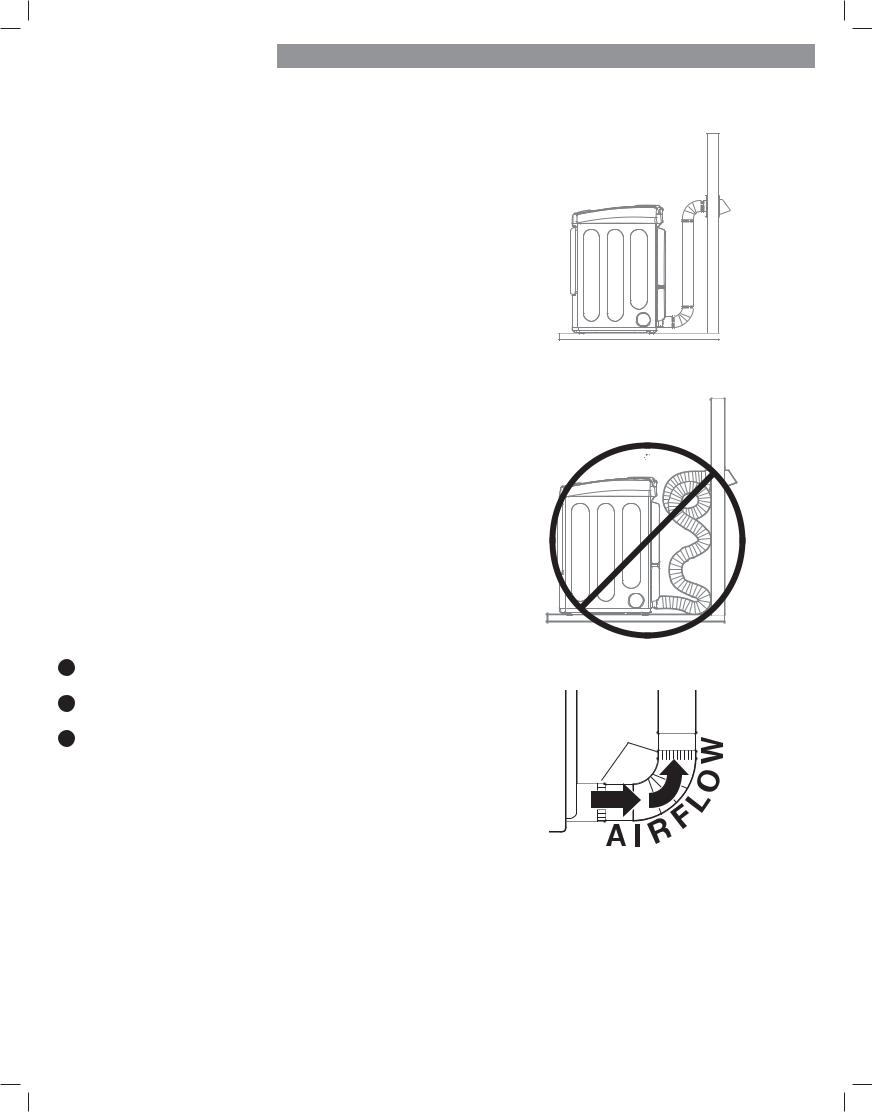
INSTALLATION INSTRUCTIONS
 VENTING THE DRYER (continued)
VENTING THE DRYER (continued)
Routing and Connecting Ductwork
Follow the guidelines below to maximize dryer performance and reduce lint buildup and condensation in the ductwork.
NOTE: Transition duct and fittings are NOT included and must be purchased separately.
•Use 4 inch (102mm) diameter rigid or semi-rigid metal duct.
•The exhaust duct run should be as short as possible.
•Use as few elbow joints as possible.
•The male end of each section of exhaust duct must point away from the dryer.
•Use duct tape on all joints. Never use screws.
•Insulate ducts that runs through unheated areas in order to reduce condensation and lint buildup on
duct surfaces.
•The total length of semi-rigid metal transition duct should not exceed 8 ft. (2.4 m).
 WARNING: Failure to follow these guidelines will result in poor performance and product failure, and may result in fire or death.
WARNING: Failure to follow these guidelines will result in poor performance and product failure, and may result in fire or death.
IMPORTANT: Failure to exhaust the dryer, per the guidelines included within these instructions, may result in unsatisfactory dryer performance. All venting and ductwork beyond the exterior of the dryer is the
responsibility of the consumer. Product failure, as a result of improper venting, is not covered by the manufacturer’s warranty.
Correct Venting |
Incorrect Venting |
Connecting the Dryer Vent
1Verify all ducts and elbows are clean and free from any blockages.
2Measure duct length. DO NOT exceed the maximum length listed in the Duct Length Chart.
3Connect dryer exhaust to existing duct.
•Only use duct tape or clamps.
•DO NOT use screws to secure ductwork.
•Use rigid or semi-rigid metal ducts.
•DO NOT use plastic or thin metal foil tubing for ductwork.
•The male end of each elbow must always point in the direction of the airflow.
NOTE: Be careful when moving the dryer into its final location. Do NOT crush the duct. Make sure the connections do not come loose.
Male
Ends
15
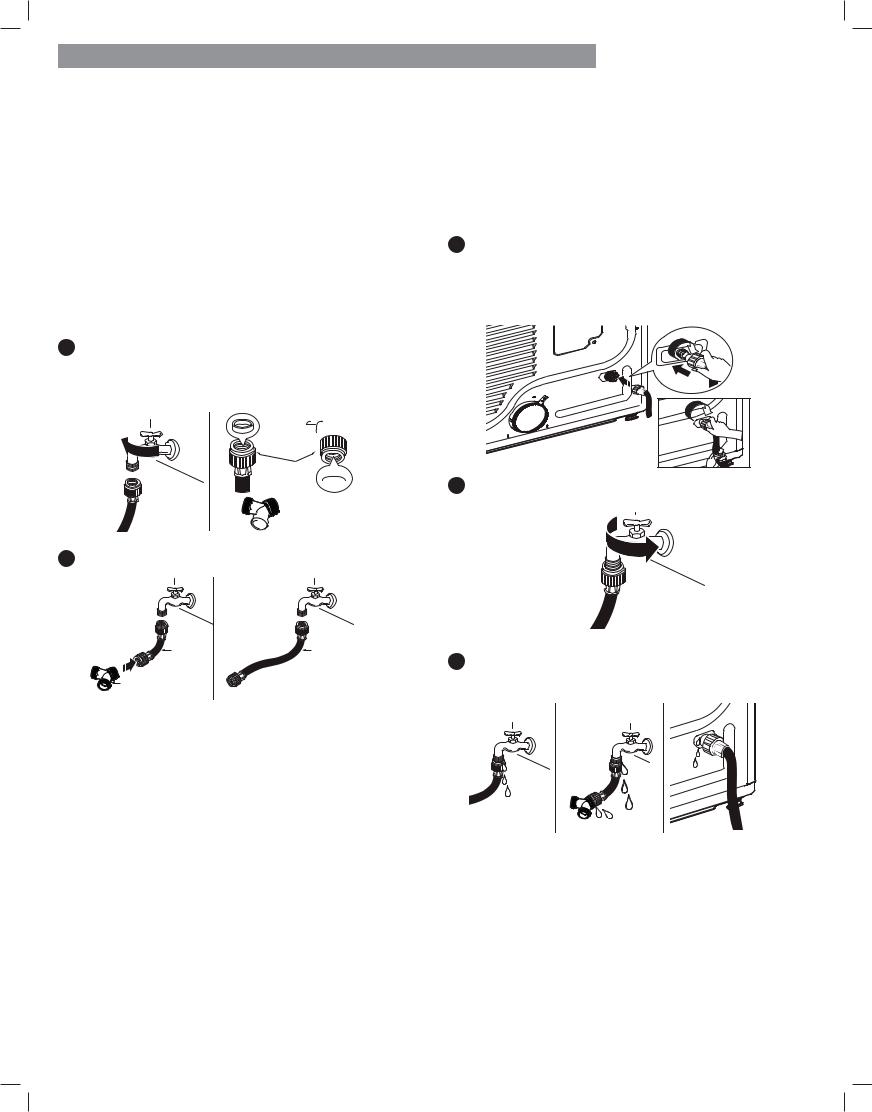
INSTALLATION INSTRUCTIONS
 CONNECTING THE INLET HOSE
CONNECTING THE INLET HOSE
The dryer must be connected to the cold water tap using the new water supply hose. Do not use old hoses.
NOTE:
•Water supply pressure must be between 20 psi and 120 psi (138–827 kPa).
•Do not strip or cross-thread when connecting inlet hose to the valve.
•If the water supply pressure is more than 120 psi
(827 kPa), a pressure reducing valve should be installed.
•Periodically check the condition of the hose and replace the hose if necessary.
•Replace inlet hoses after 5 years of use to reduce the risk of hose failure.
•Record hose installation or replacement dates on the hoses for future reference.
1Check the rubber seals in the inlet hose. Two rubber seals are supplied with the inlet hose. They are used for preventing water leaks. Make sure the connection to the cold water tap is tight.
Hose 
connector
Rubber 

seal



 Y connector
Y connector
2 Check the installation type.
Short |
Long |
hose |
hose |
Y connector |
|
WITH WASHER |
WITHOUT WASHER |
Connect all water supply hoses tightly by hand and then tighten another 2/3 turn with pliers.
WITH WASHER: When connecting the dryer to the same faucet as a washer.
a.Shut o the cold water tap and remove the washer hose.
b.Connect the short hose to the Y-connector.
c.Connect the other end of the short hose to the cold water faucet.
d.Connect the long dryer hose to one side of the Y-connector and connect the washer hose to the other side.
WITHOUT WASHER: If the dryer does not share the cold water tap with a washer.
a.Connect the straight end of the long hose to the cold water faucet.
NOTE:
•Before connecting the water line to the dryer, flush several gallons of water through the hose into
a drain or bucket. This will help prevent foreign particles such as sand and scale from clogging the dryer inlet valve.
•Do not overtighten. Damage to the coupling can result.
3 Connect the hose to the dryer.
Connect the water supply hose to the dryer inlet valve tightly by hand and then tighten another 2/3 turn with pliers. Make sure that there are no kinks in the hoses and that they are not crushed.
4 Turn on the cold water faucet.
5Check for leaks at the Y-connector (if used) and all hoses.
NOTE:
•If any leaks are found, shut o the water faucet, remove the hose and check the condition of the hose washer.
16
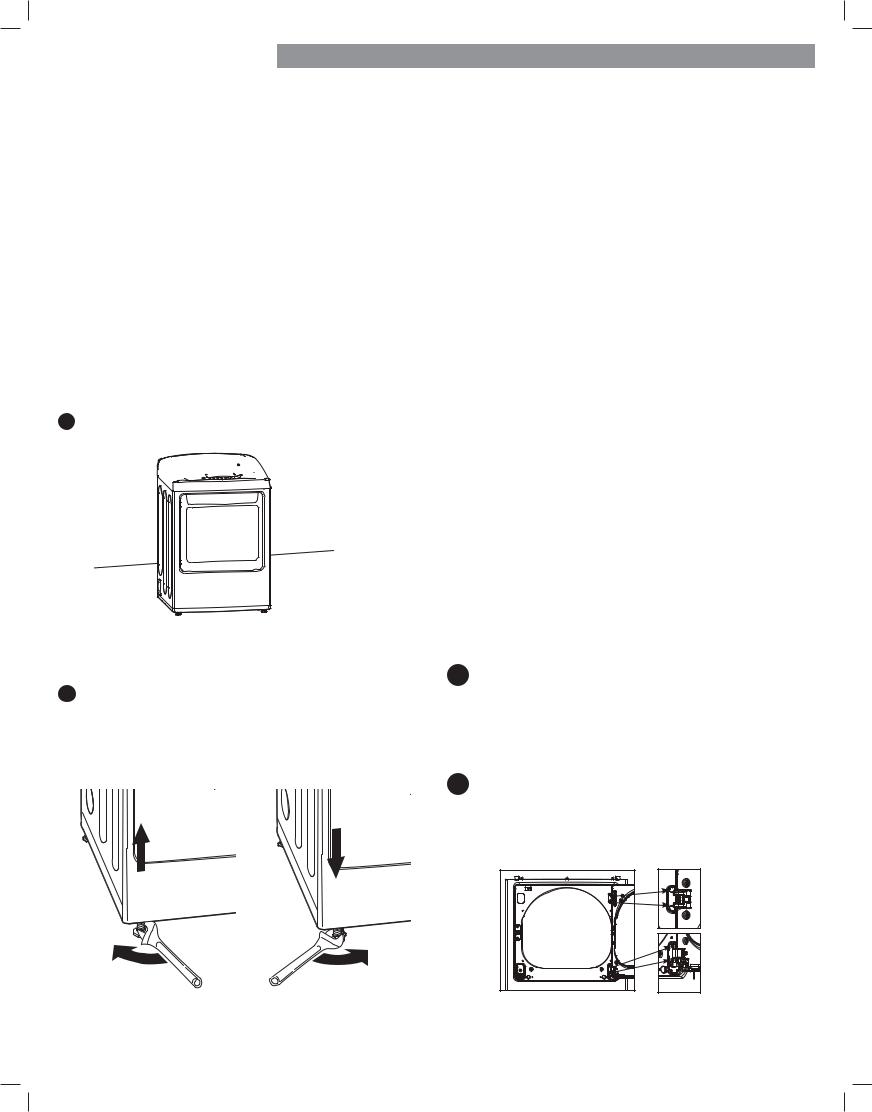
 LEVELING THE DRYER
LEVELING THE DRYER
 WARNING:
WARNING:
•To reduce the risk of injury to persons, adhere to all industry recommended safety procedures including the use of long sleeved gloves and
safety glasses. Failure to follow this warning can cause serious injury or death.
•The appliances are heavy. Two or more people are required when installing the dryer. Failure to follow this warning can cause serious injury or death.
To ensure that the dryer provides optimal drying performance, it must be level. To minimize vibration, noise, and unwanted movement, the floor must be a level, solid surface.
NOTE: Adjust the leveling feet only as far as necessary to level the dryer. Extending the leveling feet more than necessary can cause the dryer to vibrate.
1Position the dryer in the final location. Place a level across the top of the dryer.


 Level
Level
 Leveling Feet
Leveling Feet
All four leveling feet must rest solidly on the floor. Gently push on the top corners of the dryer to make sure that the dryer does not rock from corner to corner.
2Use a wrench to turn the leveling feet. Turn the leveling foot clockwise to raise the dryer or counterclockwise to lower the dryer. Using a level, adjust the feet until the dryer is level from side to side and front to back. Make sure all four feet are in firm contact with the floor.
INSTALLATION INSTRUCTIONS
 REVERSING THE DOOR SWING
REVERSING THE DOOR SWING
Tools Required
Phillips or large flat-blade screwdriver (for hinge screws)
Small flat blade screwdriver (for lifting out parts)
 WARNING:
WARNING:
THE DRYER DOOR IS VERY LARGE AND HEAVY. Failure to follow the instructions below can result in damage to the dryer, property damage or personal injury.
•To avoid damage to the dryer or the door, support the door with a stool or box that fits under the door, or have an assistant support the weight of the door.
•Avoid dropping the door to avoid damage to the door or the floor.
•Unplug the dryer or turn off power at the main circuit breaker before beginning door reversal.
Door Reversal Instructions
NOTE: The instructions here are for changing the door swing from a right to a left side hinge. If the door has been reversed, and it is necessary to change it back, use care when following these instructions. Some of the
illustrations and the left/right references will be reversed, and you will need to read the instructions carefully.
 Swing Door
Swing Door
1 Open the door from the side so that the hinge screws are accessible.
 WARNING:
WARNING:
Be sure to support the weight of the door before removing the hinge screws.
2 Remove the 4 hinge screws.
While supporting the door, remove the 4 hinge screws, 2 from each hinge. Set the door aside face down on a protected surface to prevent damage to the door or the work surface.
Two large screws
Two small screws
NOTE: If you are installing the dryer on the optional |
|
pedestal, the dryer leveling feet should be fully retracted. |
|
Use the leveling feet on the pedestal to level the dryer. |
17 |
|
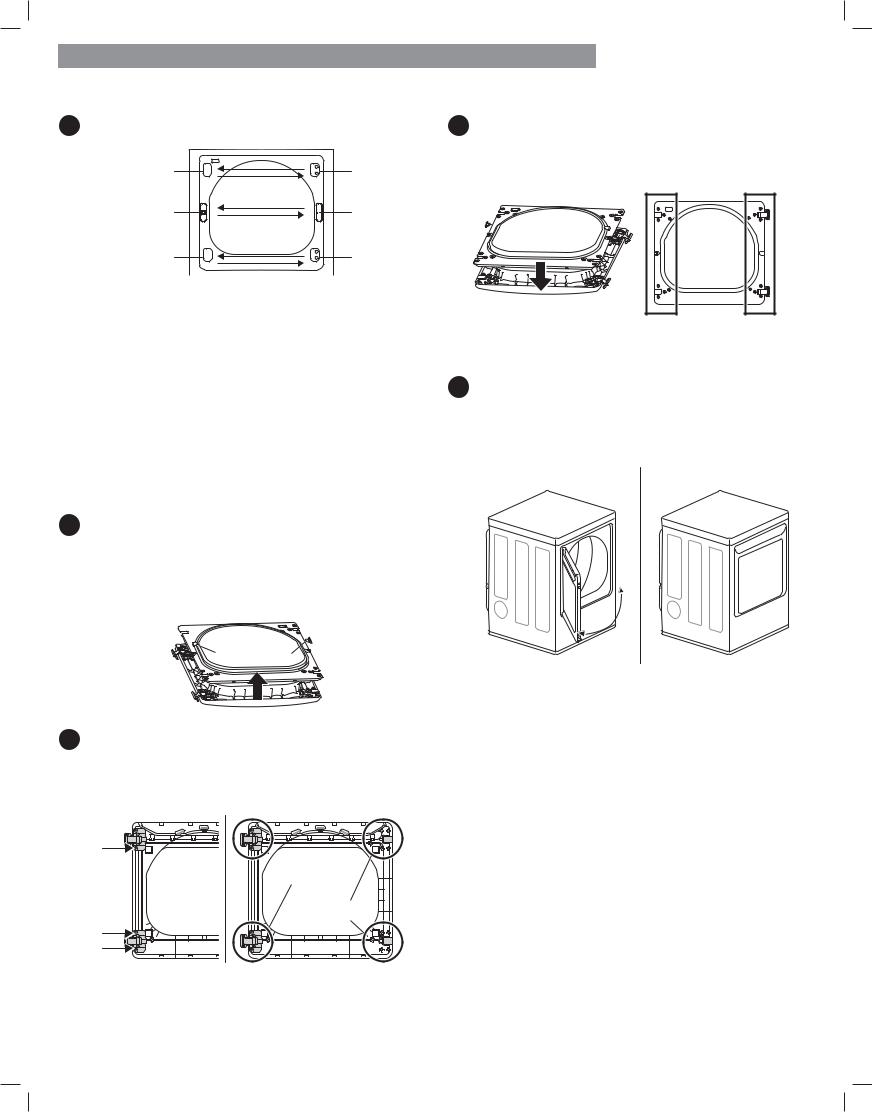
INSTALLATION INSTRUCTIONS
 REVERSING THE DOOR SWING (continued)
REVERSING THE DOOR SWING (continued)
3 Reverse the components on the cabinet.
hinge |
hinge |
|
cover |
||
|
||
latch |
latch |
|
hole |
||
mechanism |
||
cover |
||
|
||
hinge |
hinge |
|
cover |
||
|
a.Use a Phillips screwdriver to remove the 2 screws and the latch mechanism on the front panel of the cabinet.
b.Remove the latch hole cover by gently prying it up with a flat-blade screwdriver, being careful not to scratch the paint. Install the latch hole cover on the opposite side, where the latch mechanism was
removed. Install the latch mechanism in the position from which you removed the latch hole cover, using the two screws removed in step a.
c.Remove the hinge cover by gently prying it up with a flat-blade screwdriver, being careful not to scratch the paint. Rotate the hinge cover 180 degrees and install it on the opposite side, where the upper hinge was attached.
4 Remove the inner door frame.
With the door on a protected surface, remove the 16 screws around the sides of the door and lift off the inner door frame using a flat blade screwdriver. Remove the latch hook and blank and install them on the opposite side.



 Inner door
Inner door
frame
Blank Latch hook
6 Remount the inner door frame.
With the hinges and cover caps in the new locations, remount the inner door frame onto the outer door frame with the screws removed in step 4.
 WARNING:
WARNING:
Be sure to support the weight of the door before installing the hinge screws.
7 Reinstall the door.
While supporting the door, install the 4 hinge screws removed in step 2. Test the swing of the door to make sure the hinges and latch are properly aligned and that the door opens, closes, and latches properly.
Swing
Door
5 Reverse hinges and cover caps.
Remove the 4 screws securing the hinges to the door frame. Remove the 2 plastic cover caps. Reinstall the hinges and cover caps on the opposite sides from which they were removed.
 Hinge
Hinge
assembly
Cover cap
18
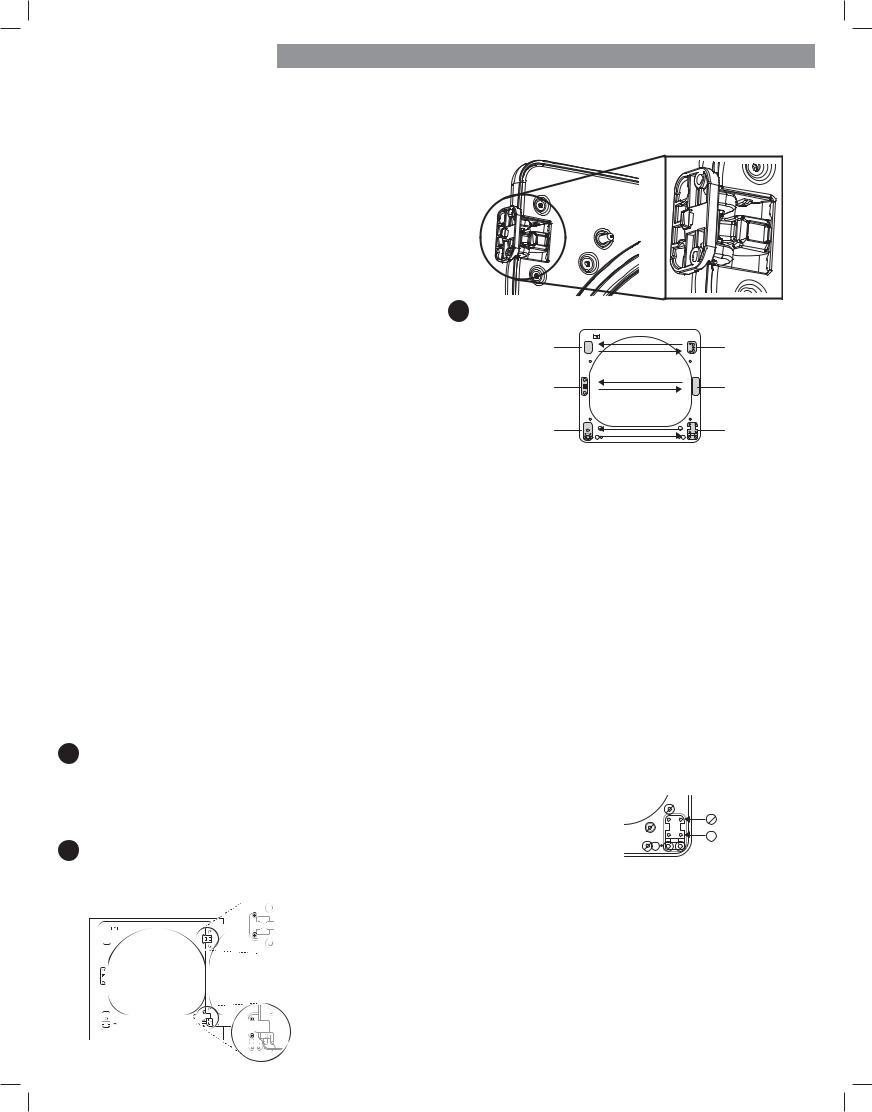
INSTALLATION INSTRUCTIONS
 REVERSING THE DOOR SWING (continued)
REVERSING THE DOOR SWING (continued)
 Two-Way Door (on some models) Before You Begin
Two-Way Door (on some models) Before You Begin
NOTE:
The door reversal procedure for the two-way door is far more complex than for a conventional dryer door. It is recommended that you read through these instructions in their entirety before beginning the process, in order to
gauge whether you prefer to have the procedure done by a professional installer or service person.
The instructions here are for changing the door swing from a right to a left side hinge. If the door has been reversed, and it is necessary to change it back, use care when following these instructions. Some of the illustrations and the left/right references will be reversed, and you will need to read the instructions carefully.
Tools Required
Phillips or large flat-blade screwdriver (for hinge screws)
Small flat blade screwdriver (for lifting out parts)
 WARNING:
WARNING:
THE DRYER DOOR IS VERY LARGE AND HEAVY. Failure to follow the instructions below can result in damage to the dryer, property damage or personal injury.
•To avoid damage to the dryer or the door, support the door with a stool or box that fits under the door, or have an assistant support the weight of the door.
•Avoid dropping the door to avoid damage to the door or the floor.
•Unplug the dryer or turn off power at the main circuit breaker before beginning door reversal.
Instructions
1 Open the door from the side so that the hinge screws are accessible.
 WARNING:
WARNING:
Be sure to support the weight of the door before removing the hinge screws.
2Remove the door from the cabinet.
a. While supporting the door, remove the 4 hinge screws.
Two large screws
Two small screws
b. Lift the door slightly to disengage the hinge support and remove the door from the cabinet.
3 Reverse the components on the cabinet.
Hinge |
Upper |
cover |
hinge |
latch |
Latch |
mechanism |
hole |
|
cover |
Hinge |
Hinge |
|
bracket |
a.Use a Phillips screwdriver to remove the 2 screws and the latch mechanism on the front panel of the cabinet.
b.Remove the latch hole cover by gently prying it up with a flat-blade screwdriver, being careful not to scratch the paint. Install the latch hole cover on the opposite side, where the latch mechanism was
removed. Install the latch mechanism in the position from which you removed the latch hole cover, using the two screws removed in step a.
c.Remove the hinge cover by gently prying it up with a flat-blade screwdriver, being careful not to scratch the paint. Rotate the hinge cover 180 degrees and install it on the opposite side, where the upper hinge was attached.
d.Reverse the hinge and the hinge bracket at the bottom of the cabinet. Remove the 2 screws from the hinge bracket at bottom right and remove the hinge bracket. Remove the lower of the 2 screws behind the hinge bracket. Do NOT remove the upper screw behind the hinge bracket. Set the parts aside.
19
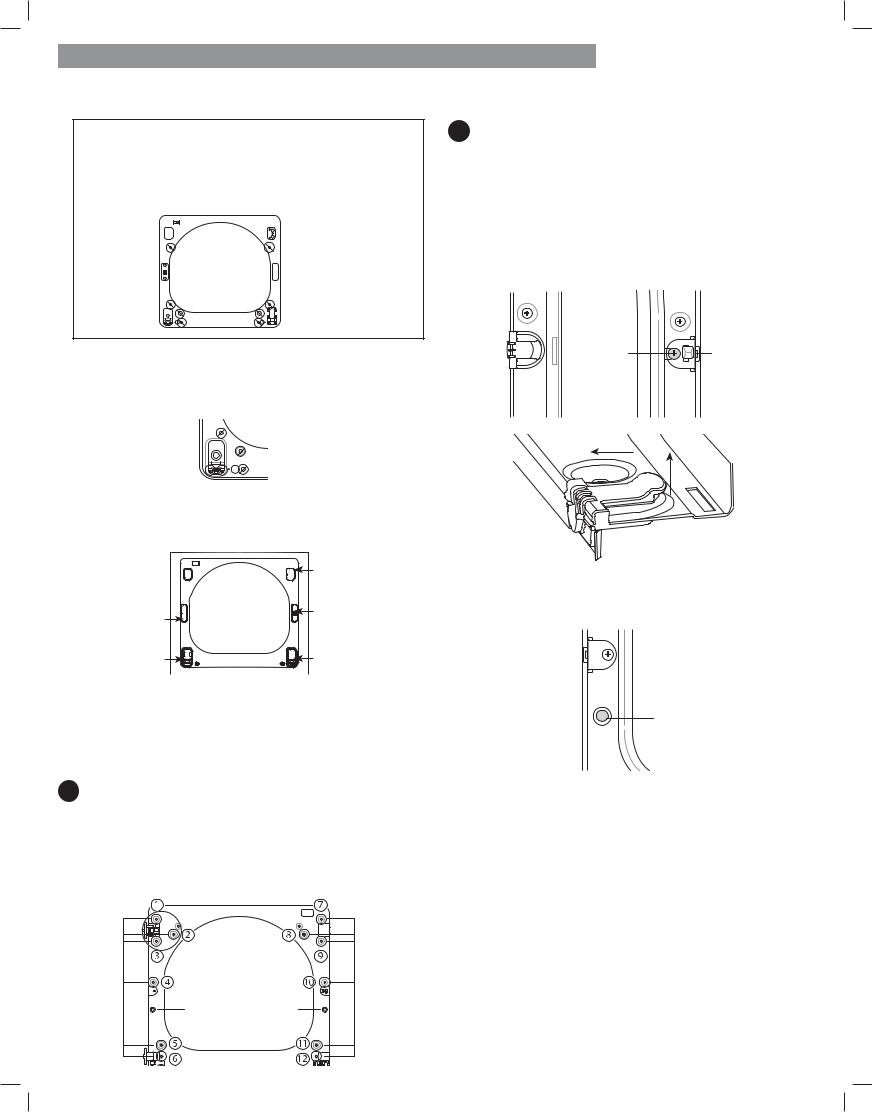
INSTALLATION INSTRUCTIONS
 REVERSING THE DOOR SWING (continued)
REVERSING THE DOOR SWING (continued)
NOTE:
Do NOT remove any of the 8 screws on the face of the cabinet (marked with  below). Doing so could result in damage to the dryer and the need for a service call to repair the dryer.
below). Doing so could result in damage to the dryer and the need for a service call to repair the dryer.
e.Remove the 3 screws on the hinge at bottom left. Remove the hinge and reinstall it on the right side. The top screw occupies the hole where you removed the screw behind the hinge bracket in step d.
f.Install the hinge bracket removed in step d on the bottom left side, first installing 1 screw behind the hinge bracket.
Cabinet Reversal complete
|
hinge |
|
cover |
latch hole |
latch |
cover |
mechanism |
hinge |
hinge |
bracket |
|
On the Door:
 CAUTION:
CAUTION:
The edges of the door cover may be sharp. Wear gloves when handling to avoid injury.
4 Lift off the door cover.
With the door laid inside facing up on a protected surface, remove the 12 screws on the inside of the door. Carefully lift off the door cover with the help of a small flat-blade screwdriver inserted in the upper corner (circled below).
Twelve screws
5 Switch the door strike and the blank cover.
Remove the 2 screws on the door cover that secure the door strike.
Switch the door strike and the blank cover, installing them on the opposite sides from which they were removed.
It may be difficult to insert the 2 screws in the door strike on the opposite side. Use a cordless screwdriver if necessary.
Short |
Long |
screws |
screw |
Blank cover |
Door strike |
|
Pull |
Raise
Remove blank cover
Gently pry out the hole plug on the side of the door cover and install it in the hole on the opposite side.
Hole plug
Set the door cover aside.
Hole |
Side |
plug |
Interlock |
|
button |
20
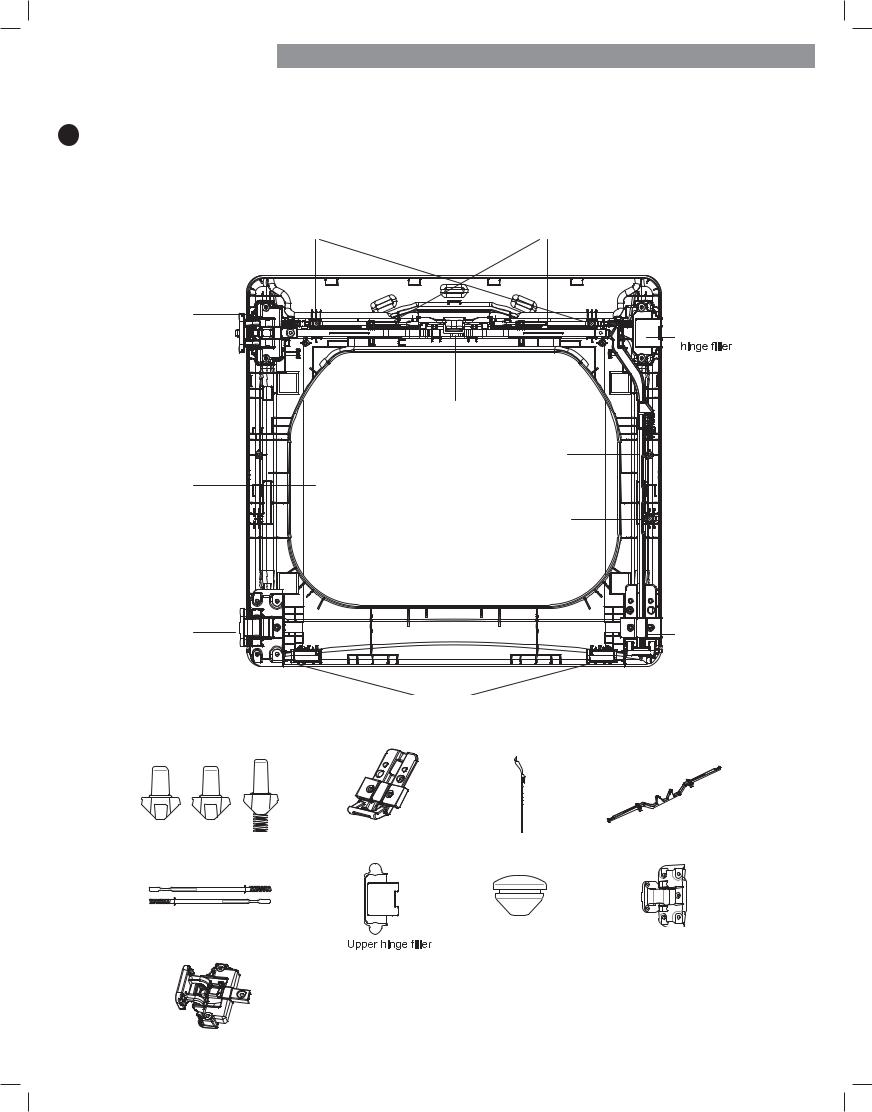
INSTALLATION INSTRUCTIONS
 REVERSING THE DOOR SWING (continued)
REVERSING THE DOOR SWING (continued)
6 Reverse the components inside the door.
You will now be removing and reversing various components inside the door. See below for a detailed diagram and identification of the inner structure and parts of the door. (The diagram shows the "before view" of the door, with the default set-up for a right side hinge swing. After following these instructions, the door should be a mirror image of the illustration.)
Top interlock buttons |
Inner lock rods |
Upper hinge
assembly
Upper
Top lock rod
Side lock rod
Glass
Side Interlock button
Lower |
Lower |
hinge |
|
assembly |
hinge |
|
bracket |
|
Bumpers |
Interlock buttons |
Lower hinge bracket |
Side lock rod |
Top lock rod |
Inner lock rods |
Hole plug |
Lower hinge assembly |
Upper hinge assembly
21
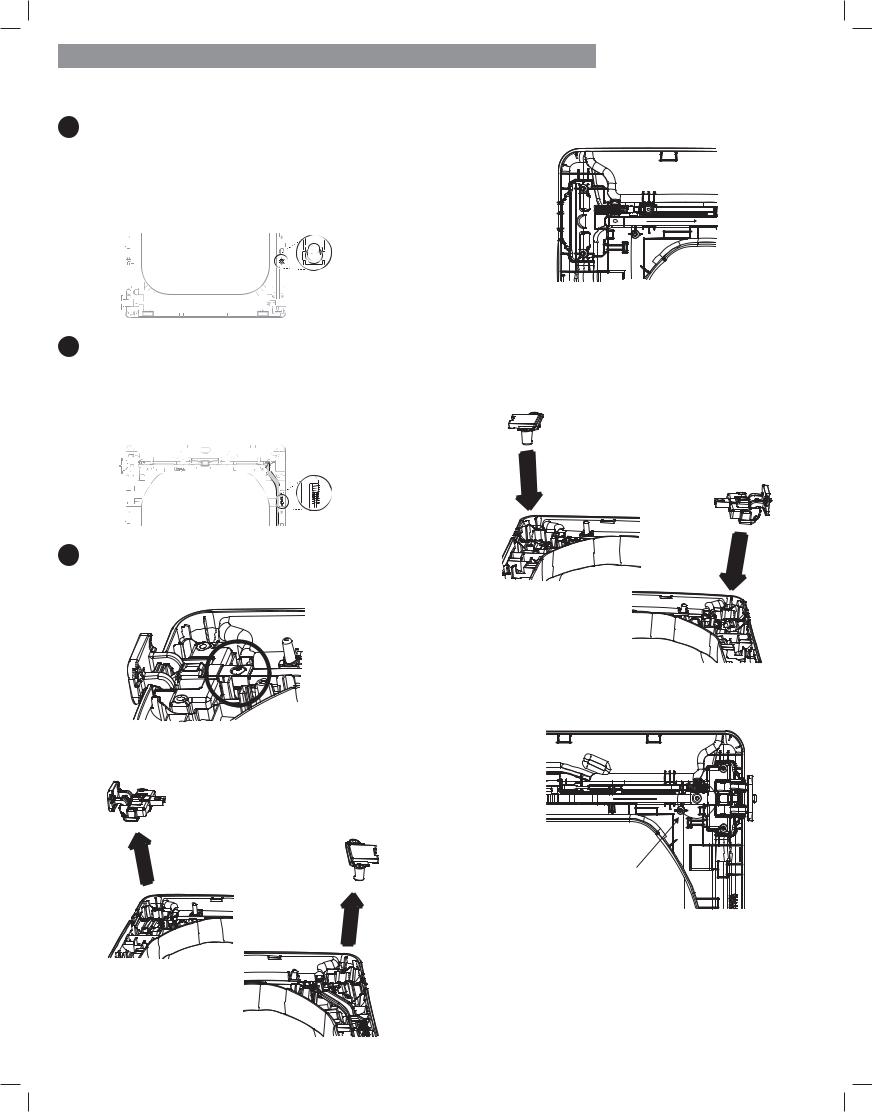
INSTALLATION INSTRUCTIONS
 REVERSING THE DOOR SWING (continued)
REVERSING THE DOOR SWING (continued)
7 Lift out the gray interlock button in the side of the
door.
Make sure to remove the spring with the interlock button and to keep the two together. Set the interlock button aside. Do not confuse this with the interlock buttons from the top of the outer door.
8 Remove the side lock rod.
Remove the side lock rod from the lower hinge bracket by lifting the top end of the rod and sliding it toward the top of the door. The spring should remain attached to the lock rod. Set the lock rod aside.
Spring
9Reverse the upper hinge assembly and hinge filler.
a. Remove the screw connecting the upper hinge assembly to the top lock rod and set it aside.
b.Lift out the upper hinge filler (on the right) and set it aside.
c. Lift out the upper hinge assembly (on the left).
d.Slide the upper lock rod to the right. Rotate the upper hinge assembly 180 degrees, and install it over the lock rod on the right, where you removed the upper hinge filler. Press firmly to fully seat the hinge assembly.
e.Rotate the hinge filler 180 degrees and install it on the upper left side of the door.
f.Insert and tighten the screw connecting the upper hinge assembly to the top lock rod, removed in step a.
Assemble screw |
22
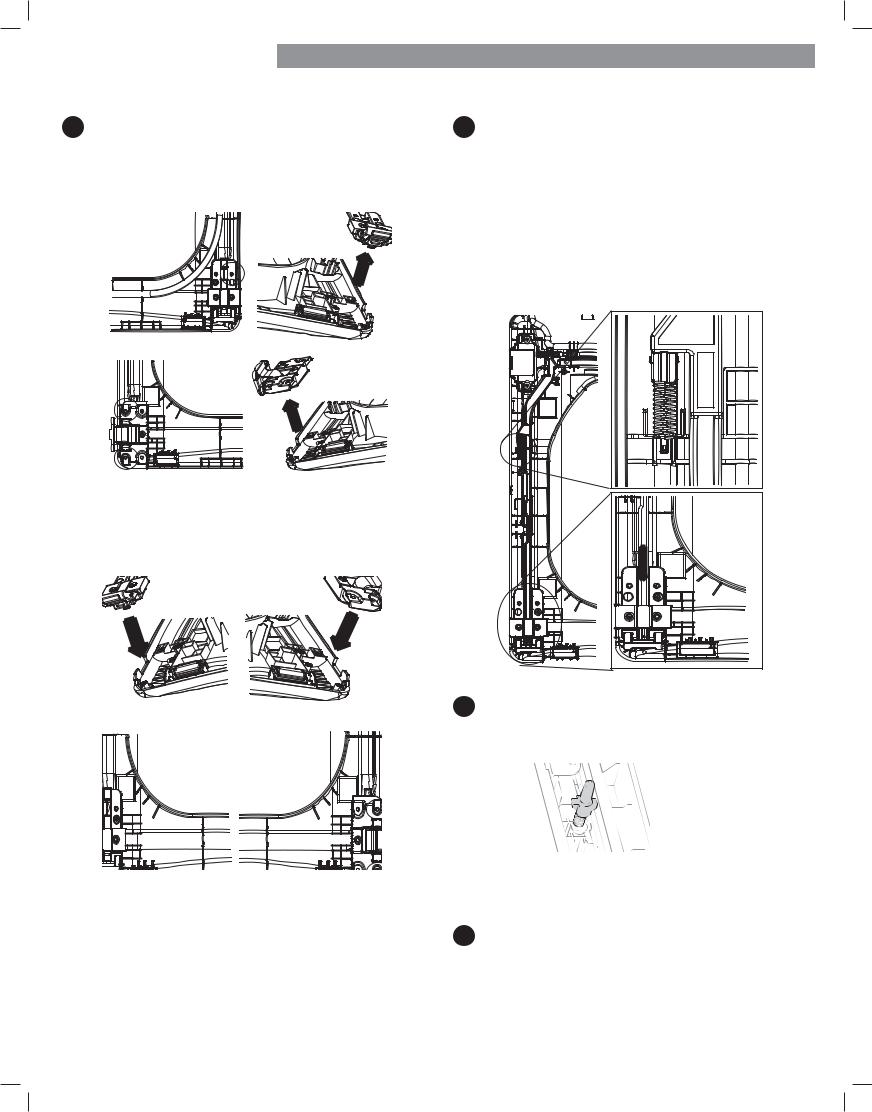
INSTALLATION INSTRUCTIONS
 REVERSING THE DOOR SWING (continued)
REVERSING THE DOOR SWING (continued)
10Reverse the lower hinge bracket and hinge assembly.
a. Remove 1 screw from the lower hinge bracket (on the right) and lift it out. Remove 2 screws from the lower hinge assembly (on the left) and lift it out.
b.Rotate the lower hinge assembly 180 degrees and install it on the right side using the 2 screws removed in step a.
c.Mount the lower hinge bracket on the lower left with the screw removed in step a.
11Install the side lock rod.
a.Flip the side lock rod over and insert the lower end into the left hinge bracket.
b.Lower the rod into the guides on the door while compressing the spring inside the recess.
NOTE:
•Make sure the top of the side lock rod is beside the top lock rod and the two do not overlap each other. If they are not aligned properly, the door will not operate properly.
•Make sure the spring stays on the side lock rod.
12 Reinstall the side interlock button.
Install the side interlock button on the opposite side from which it was removed.
NOTE:
Make sure the spring is on the interlock button and is centered in the compartment.
13Reinstall the door cover.
a.Clean the class on the door and door cover, if necessary.
b.Make sure the 3 gray interlock buttons are properly installed and that the top and side lock rods intersect properly.
23
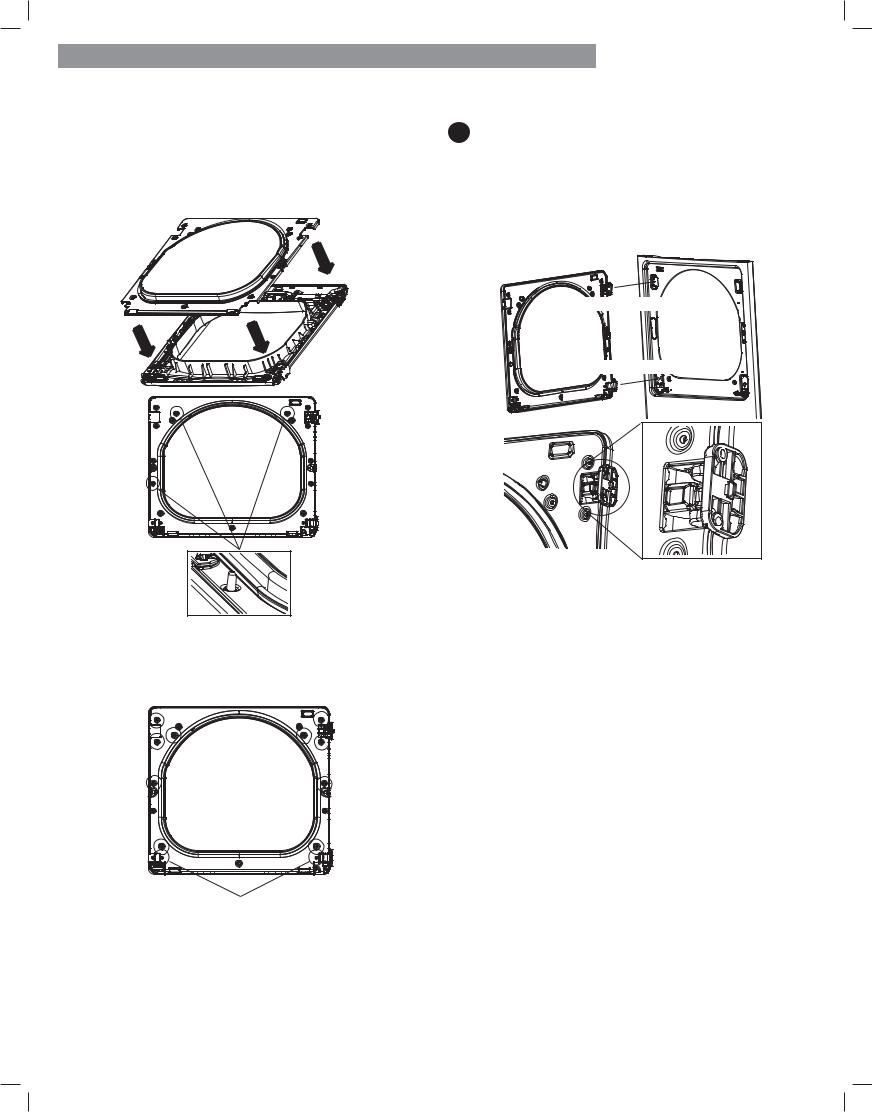
INSTALLATION INSTRUCTIONS
 REVERSING THE DOOR SWING (continued)
REVERSING THE DOOR SWING (continued)
c.Carefully lower the door cover into place, aligning the holes in the cover with the 3 interlock buttons and the bumpers on the bottom edge. You may need to force fit the door cover.
d.Once the door cover is in place, secure it with the 12 screws removed in step 4.
14 Reassemble the door on the cabinet.
While supporting the door, insert the hinge support into the slot in the door and slide the door down slightly to seat it. Install the 4 hinge screws removed in step 2. Test the swing of the door to check the alignment of the hinges and latch. Make sure the door opens, closes, and latches properly in both directions.
Two large screws
Two small screws
If the door is damaged, or if the door does not work after reassembly, contact the call center at 1-800-469-4663.
NOTE:
Make sure the 3 interlock buttons are aligned with the holes in the door cover.
Two different screws
NOTE:
10 similar screws are inserted in the top and sides of the door cover. The 2 different screws are inserted in the bottom edge.
24
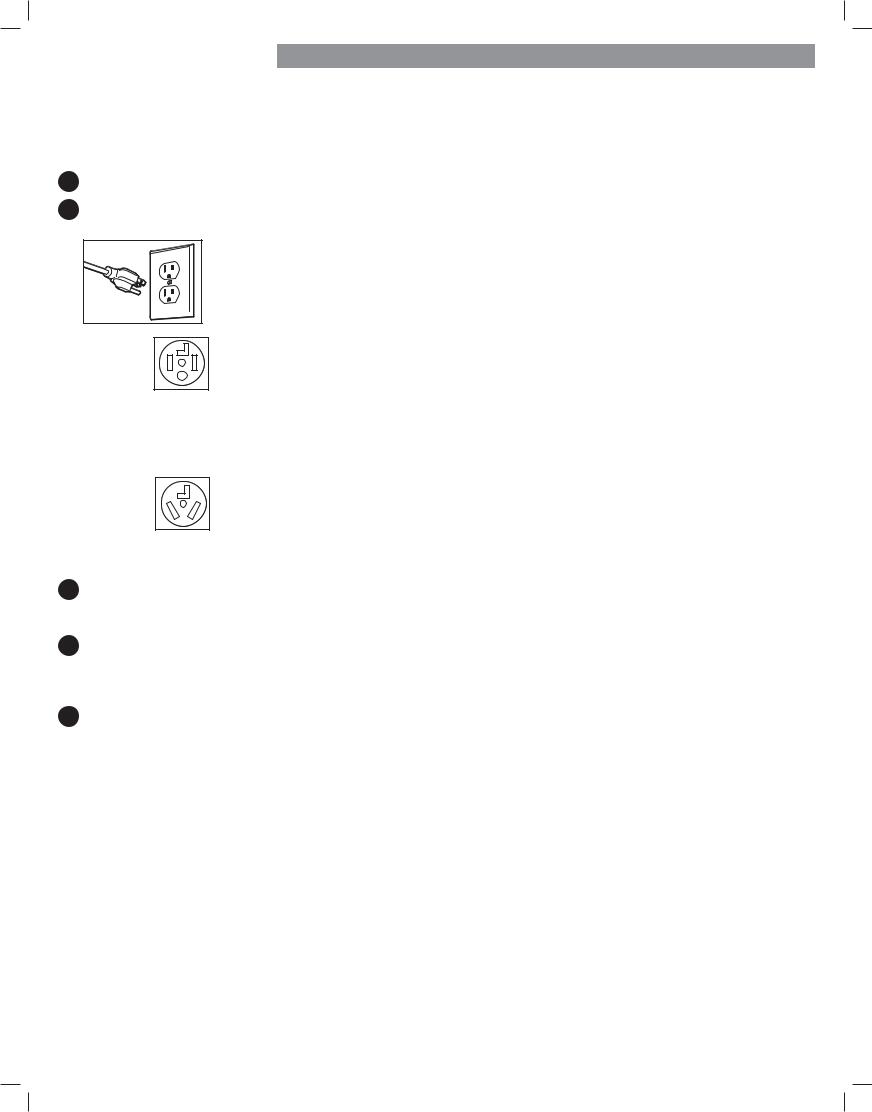
 FINAL INSTALLATION CHECK
FINAL INSTALLATION CHECK
Once you have completed the installation of the dryer and it is in its final location, confirm proper operation with the following steps and tests.
1Is gas turned on? (Gas models only)
2Is dryer plugged in? Dryer should always be plugged into the proper outlet.
Gas dryer should use a 120-
VAC, 60-Hz. grounded 3-prong
Electric dryer should use a 4-wire connection which is required for all mobile and manufactured home installations, as well as all new construction after January 1, 1996.
-- OR --
A 3-wire connection.
NOTE: A 3-wire connection is NOT permitted on new construction after
January 1, 1996.
3Is the dryer transition duct connected? Make sure the transition duct behind the dryer is properly connected and is not crushed or damaged.
4Is the dryer level? Once the dryer is in its final location, recheck the dryer to be sure it is level. Make sure it is level front to back and side to side, and that all four leveling feet rest firmly on the floor.
5Is the dryer heating normally? Perform the following dryer heating test.
INSTALLATION INSTRUCTIONS
Testing Dryer Heating
GAS MODELS
Close the dryer door, press the POWER button to turn the dryer on, and start the dryer on a heat setting. When the dryer starts, the igniter should ignite the main burner.
NOTE: If all air is not purged from the gas line, the gas igniter may turn o before the main burner ignites. If this happens, the igniter will reattempt gas ignition until all the air is purged from the gas line.
ELECTRIC MODELS
Close the dryer door, press the POWER button to turn the dryer on, and start the dryer on a heat setting. The exhaust air should be warm after the dryer has been operating for 3 minutes.
Checking Airflow
E ective dryer operation requires proper airflow. The adequacy of the airflow can be measured by evaluating the static pressure. Static pressure in the exhaust duct can be measured with a manometer, placed on the exhaust duct approximately 2 ft. (60.9 cm) from the dryer. Static pressure in the exhaust duct should not exceed 0.6 inches (1.5 cm). The dryer should be checked while the dryer is running with no load.
Checking Levelness
Once the dryer is in its final location, recheck the dryer to be sure it is level. Make sure it is level front to back and side to side, and that all four leveling feet are firmly on the floor.
Checking Venting
The vent duct should be checked for lint buildup and cleaned at least once per year. If any noticeable reduction in drying performance occurs, check the duct for obstructions and blockages.
25
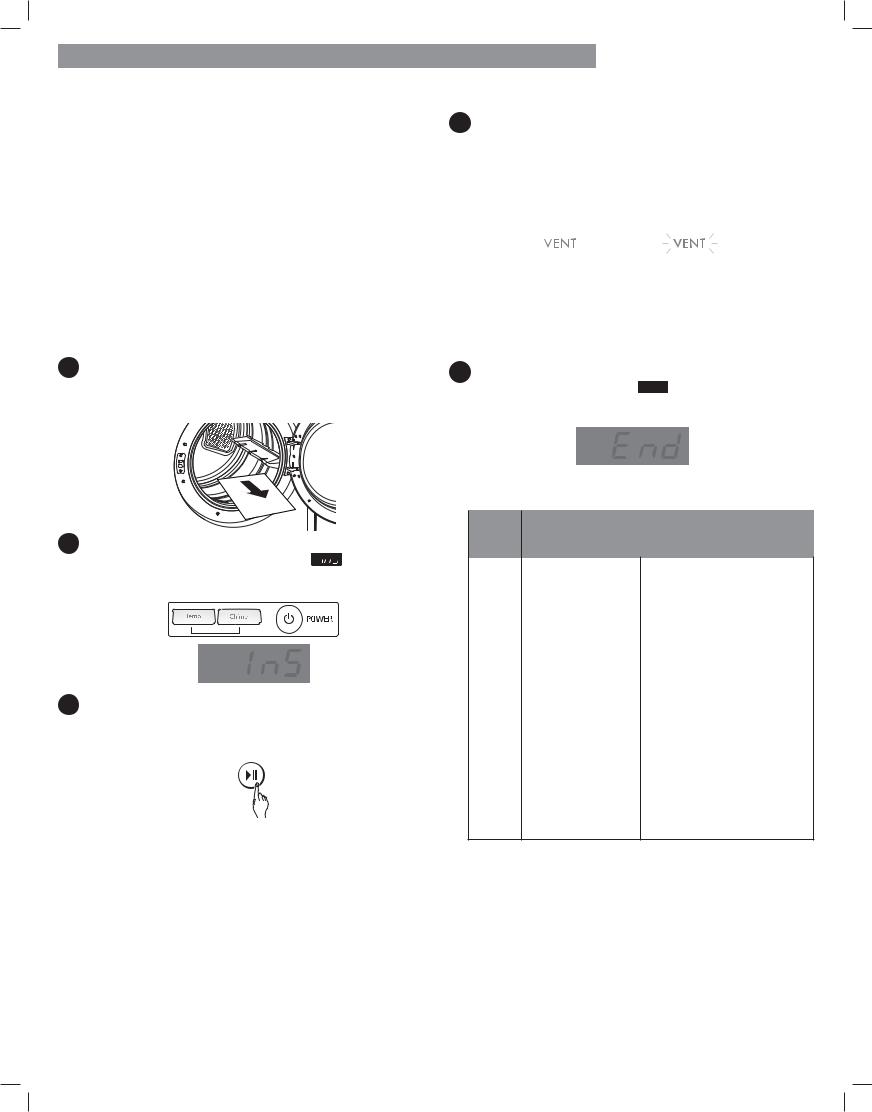
INSTALLATION INSTRUCTIONS
 INSTALLATION TEST (DUCT CHECK)
INSTALLATION TEST (DUCT CHECK)
Once you have completed the installation of the dryer, use this test to make sure the condition of the exhaust system is adequate for proper operation of the dryer. This test should be performed to alert you to any serious problems in the exhaust system of your home.
The dryer features Vent, an innovative sensing system that automatically detects blockages and restrictions in dryer ductwork. Keeping ductwork clean of lint buildup and free of restrictions allows clothes to dry faster and reduces energy use.
NOTE: The dryer should be cool before starting this test. If the dryer was warmed up during installation, run the Air Dry cycle for a few minutes to reduce the interior temperature.
To activate the installation test:
1Remove the literature and any other contents from inside the dryer, then close the dryer door.
Do not load anything in the drum for this test, as it may a ect the accuracy of the results.
2Press the Power button, then immediately press and hold both the Temp and Chime buttons until 

 appears in the display.
appears in the display.
3Press the START/PAUSE button.
The dryer will start the test, which lasts about 2 minutes. The heat is turned on and the temperatures in the drum are measured.
4Check the display for results.
During the test cycle, monitor the VENT LED on the control panel. If the LED does not blink by the time the cycle ends, the exhaust system is adequate. If the exhaust system is severely restricted, the VENT LED blinks. Have the exhaust system checked immediately, as dryer performance will be poor.
Not blinking: |
Blinking: |
OK |
RESTRICTED |
Other problems may also be shown with error codes. Refer to the table below for error code details and solutions.
5End of cycle.
At the end of the test cycle, 


 appears in the display. The test cycle ends and the dryer shuts o automatically after a short delay.
appears in the display. The test cycle ends and the dryer shuts o automatically after a short delay.
Check any error codes in the chart below before calling for service.
Error |
Possible Causes |
Solutions |
|
Code |
|||
|
|
||
|
|
|
tE1 |
Temperature |
Turn o dryer and call for |
|||
or |
|||||
sensor failure |
service. |
||||
tE2 |
|||||
|
|
|
|
||
|
|
|
|||
HS |
Humidity sensor |
Turn o dryer and call for |
|||
failure |
service. |
||||
|
|||||
|
• |
Electric dryer |
• |
Check power supply or |
|
|
|
connection of power |
|||
|
|
power cord is |
|
cord to terminal block. |
|
|
|
not connected |
|
Refer to the Connecting |
|
|
|
correctly, or |
|
Electric Dryers section of |
|
PS |
|
house power |
|
this guide for complete |
|
|
supply is |
|
instructions. |
||
or PF |
|
incorrect. |
|
|
|
or nP • |
House fuse is |
• |
Reset circuit breaker |
||
|
|
blown, circuit |
|
or replace fuse. Do not |
|
|
|
breaker has |
|
increase fuse capacity. |
|
|
|
tripped, or |
|
If problem is a circuit |
|
|
|
power outage |
|
overload, have it |
|
|
|
has occurred. |
|
corrected by a qualified |
|
|
|
|
|
electrician. |
|
26

Check the duct condition.
If the VENT LED is blinking, check the exhaust system for restrictions and damage. Repair or replace the exhaust system as needed.
NOTE: When the dryer is first installed, this test should be performed to alert you to any existing problems with the exhaust ducts in your home.
However, since the test performed during normal operation provides more accurate information on the condition of the exhaust duct than does the
installation test, the results of the two tests may not be the same.
Do not interrupt the test cycle, as this could result in inaccurate results.
Even if the LED is not blinking during the test cycle, some restrictions may still be present in the exhaust system. Refer to the Venting the Dryer section of this guide for complete exhaust system and venting requirements.
INSTALLATION INSTRUCTIONS
 RESTRICTED OR BLOCKED AIRFLOW
RESTRICTED OR BLOCKED AIRFLOW
Avoid long runs or runs with multiple elbows or bends.
|
|
|
|
|
|
|
|
|
|
|
|
|
|
|
|
|
|
|
|
|
|
|
|
|
|
|
|
|
|
|
|
|
|
|
|
|
|
|
|
|
|
|
|
|
|
|
|
|
|
|
|
|
|
|
|
|
|
|
|
|
|
|
|
|
|
|
|
|
|
|
|
|
|
|
|
|
|
|
|
|
|
|
|
|
|
|
|
|
|
|
|
|
|
|
|
|
|
|
|
|
|
|
|
|
|
|
|
|
|
|
|
|
|
|
|
|
|
|
|
|
|
|
|
|
|
|
|
|
|
|
|
|
|
|
|
|
|
|
|
|
|
|
|
|
|
|
|
|
|
|
|
|
|
|
|
|
|
|
|
|
|
|
|
|
|
|
|
|
|
|
|
|
|
|
|
|
|
|
|
|
|
|
|
|
|
|
|
|
|
|
|
|
|
|
|
|
|
|
|
|
|
|
|
|
|
|
|
|
|
|
|
|
|
|
|
|
|
|
|
|
|
|
|
|
|
|
|
|
|
|
|
|
|
|
|
|
|
|
|
|
|
|
|
|
|
|
|
|
|
|
|
|
|
|
|
|
|
|
|
|
|
|
|
|
|
|
|
|
|
|
|
|
|
|
|
|
|
|
|
|
|
|
|
|
|
|
|
|
|
|
|
|
|
|
|
|
|
|
|
|
|
|
|
|
|
|
|
|
|
|
|
|
|
|
|
|
|
|
|
|
|
|
|
|
|
|
|
|
|
|
|
|
|
|
|
|
|
|
|
|
|
|
|
|
|
|
|
|
|
|
|
|
|
|
|
|
|
|
|
|
|
|
|
|
|
|
|
|
|
|
|
|
|
|
|
|
|
|
Excess or crushed |
|
Too many elbows or |
|
||||||||||||||||||||||
|
|
transition duct |
|
|
|
exhaust too long |
|
|||||||||||||||||||
Check for blockages and lint buildup.
Lint buildup or blockage
Make sure the ductwork is not crushed or restricted.
Crushed or damaged exhaust
27

HOW TO USE
 WARNING: To reduce the risk of fire, electric shock, or injury to persons, read this entire manual, including the Important Safety Instructions, before operating this dryer.
WARNING: To reduce the risk of fire, electric shock, or injury to persons, read this entire manual, including the Important Safety Instructions, before operating this dryer.
 CONTROL PANEL FEATURES
CONTROL PANEL FEATURES
D A I F D H
G B
APOWER (ON/OFF) BUTTON
Press to turn the dryer ON. Press again to turn the dryer OFF. Pressing the POWER button during a cycle will cancel that cycle and any settings will be lost.
B CYCLE BUTTONS
Press the CYCLE buttons to select the desired cycle. The standard presets for the selected cycle will be shown in the display. On MANUAL DRY cycles, these settings can be adjusted using the cycle setting buttons any time before starting the cycle.
C START/PAUSE BUTTON
Press this button to START the selected cycle. If the dryer is running, use this button to PAUSE the cycle without losing the current settings.
NOTE: If the dryer has been stopped for more than 60 minutes, the dryer will turn o automatically and all settings will be lost.
D OPTION BUTTONS
These buttons allow you to select cycle options. Some of the option buttons have secondary functions. The controls can be locked or unlocked by pressing and holding the CHIME button for three seconds.
E CYCLE MODIFIER BUTTONS
Use these buttons to adjust the settings for the selected cycle. The settings light up above the buttons to show the current selection. The default temperature setting cannot be changed in AUTO DRY cycles. AUTO DRY cycles are modified using the Dry Level button.
NOTE: To protect your fabrics, not all settings are allowed in all cycles.
C E
F TIME AND STATUS DISPLAY
The display shows the estimated time remaining for auto cycles and actual time for timed cycles. The status of the cycle is also displayed. The CHECK VENT indicator will illuminate if there is a serious restriction in the exhaust system.
G MORE TIME/LESS TIME BUTTONS
Use these buttons with the TIMED DRY and other MANUAL DRY cycles to adjust the drying time. Press the MORE TIME button to increase the selected manual cycle time by one minute; press LESS TIME to decrease the cycle time by one minute.
H VENT INDICATOR
(DUCT BLOCKAGE SENSING SYSTEM)
The VENT duct blockage sensing system detects and alerts you to blockages in the ductwork that reduce exhaust flow from the dryer. This light does not indicate any problems with your dryer. If this light blinks, it indicates that your home’s exhaust system has a serious restriction, which is not covered by your dryer’s warranty. There are services available for cleaning/maintaining the external venting.
I STEAM REFRESH CYCLE
The STEAM REFRESH cycle uses the power of steam to quickly reduce wrinkles and odor in fabrics. It also refreshes wrinkled clothes that have been stored for an extended period of time, and it can make heavily wrinkled clothes easier to iron. STEAM REFRESH can also be used to help reduce odors in fabrics.
28
